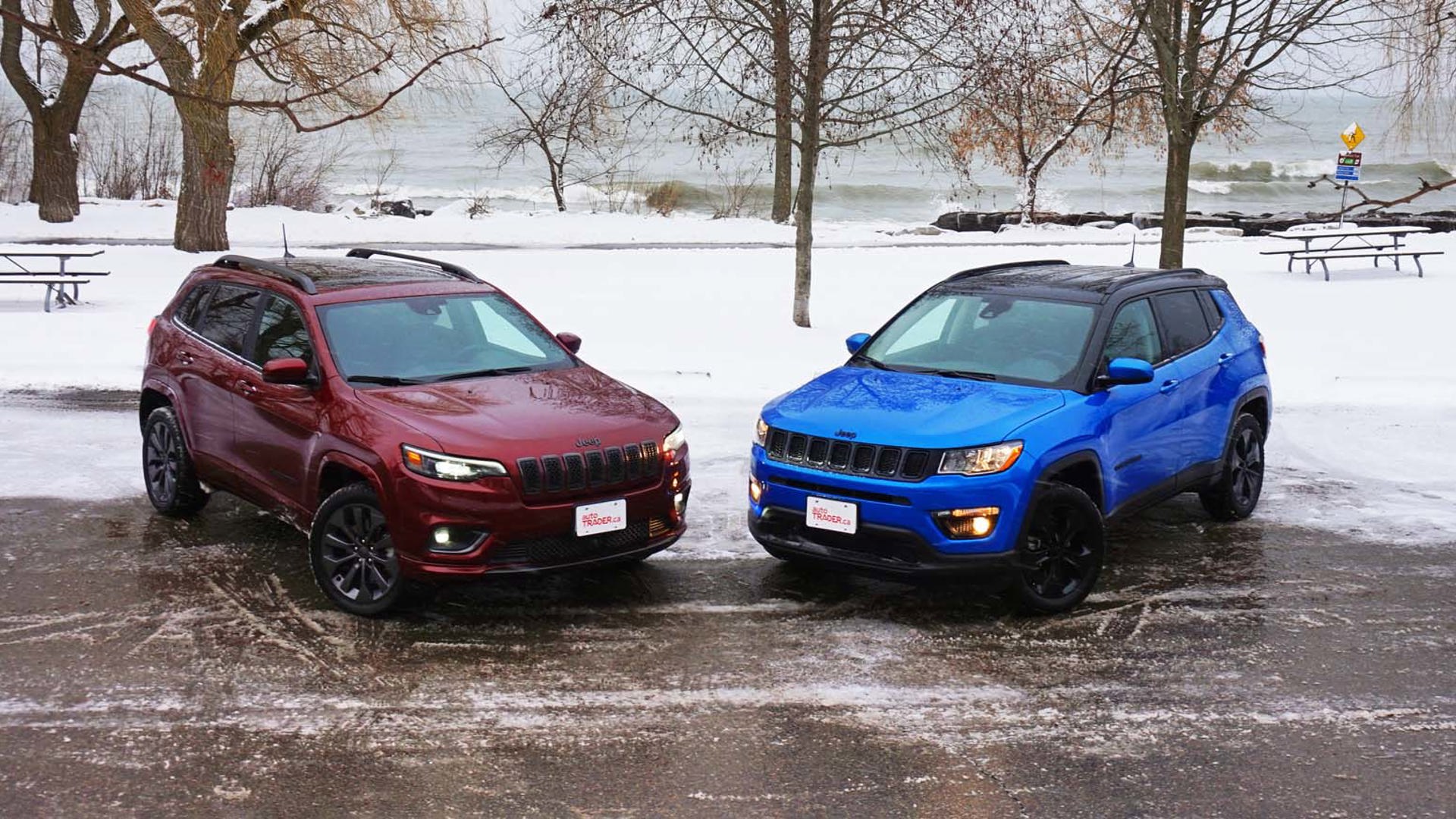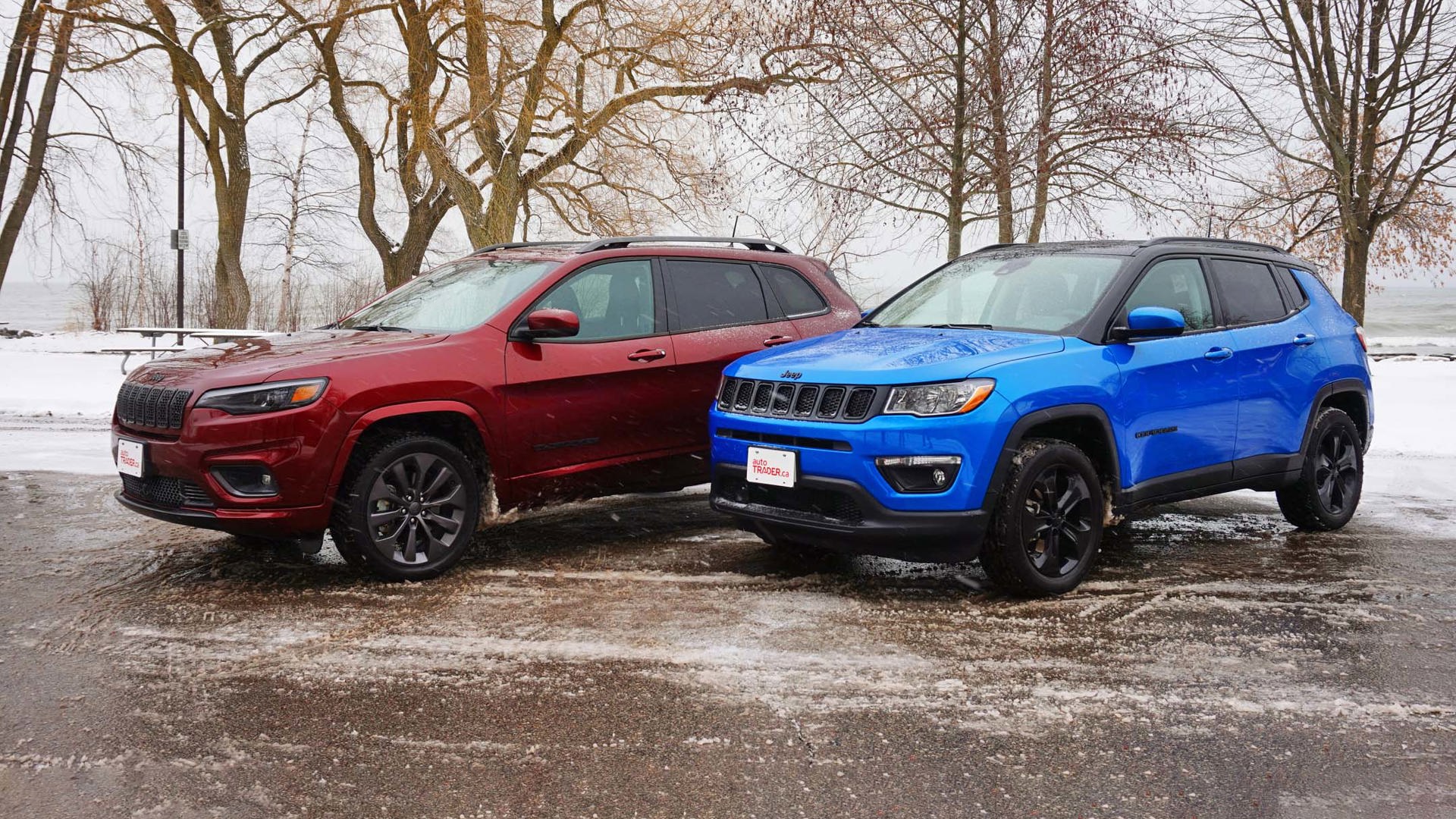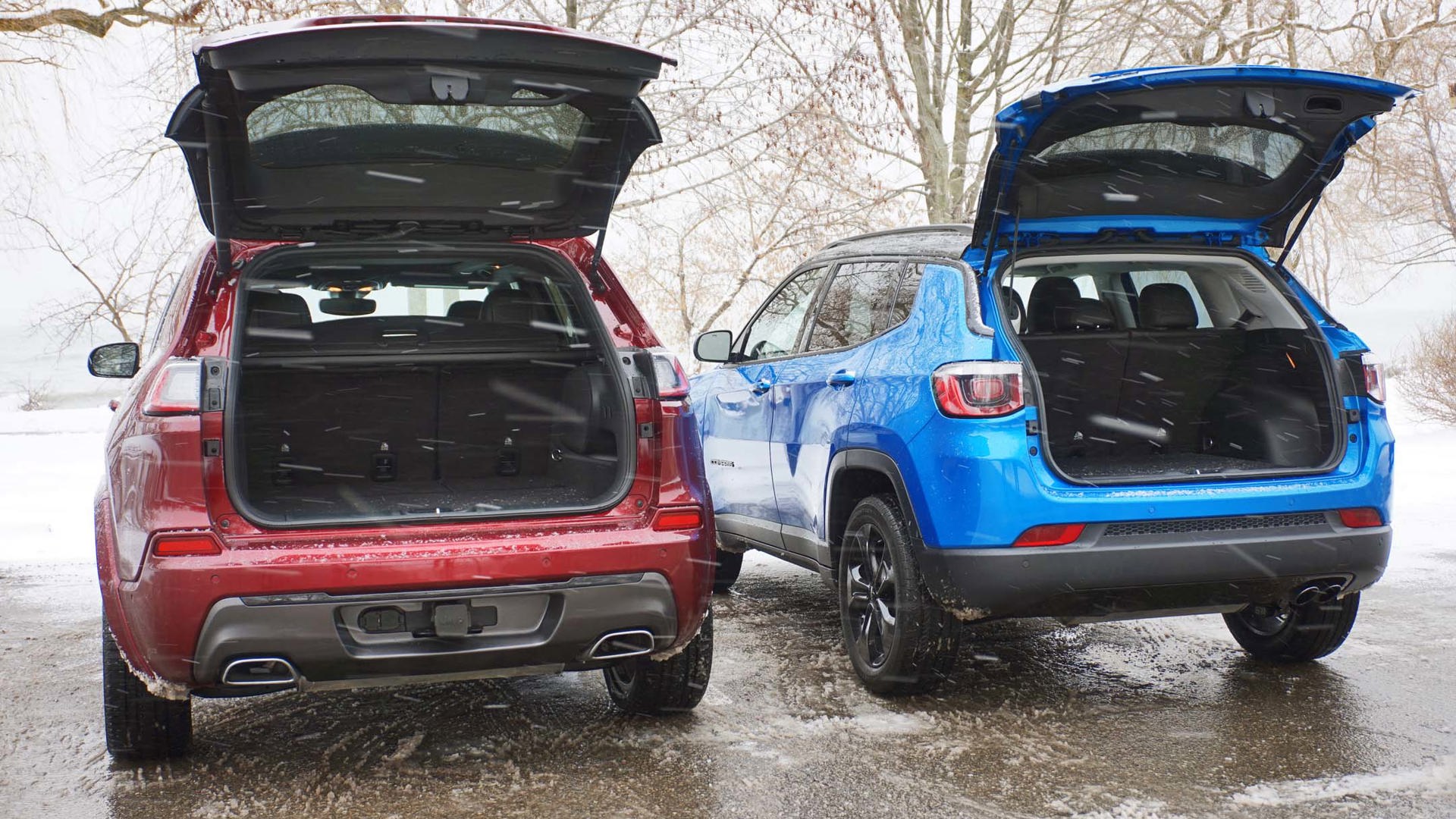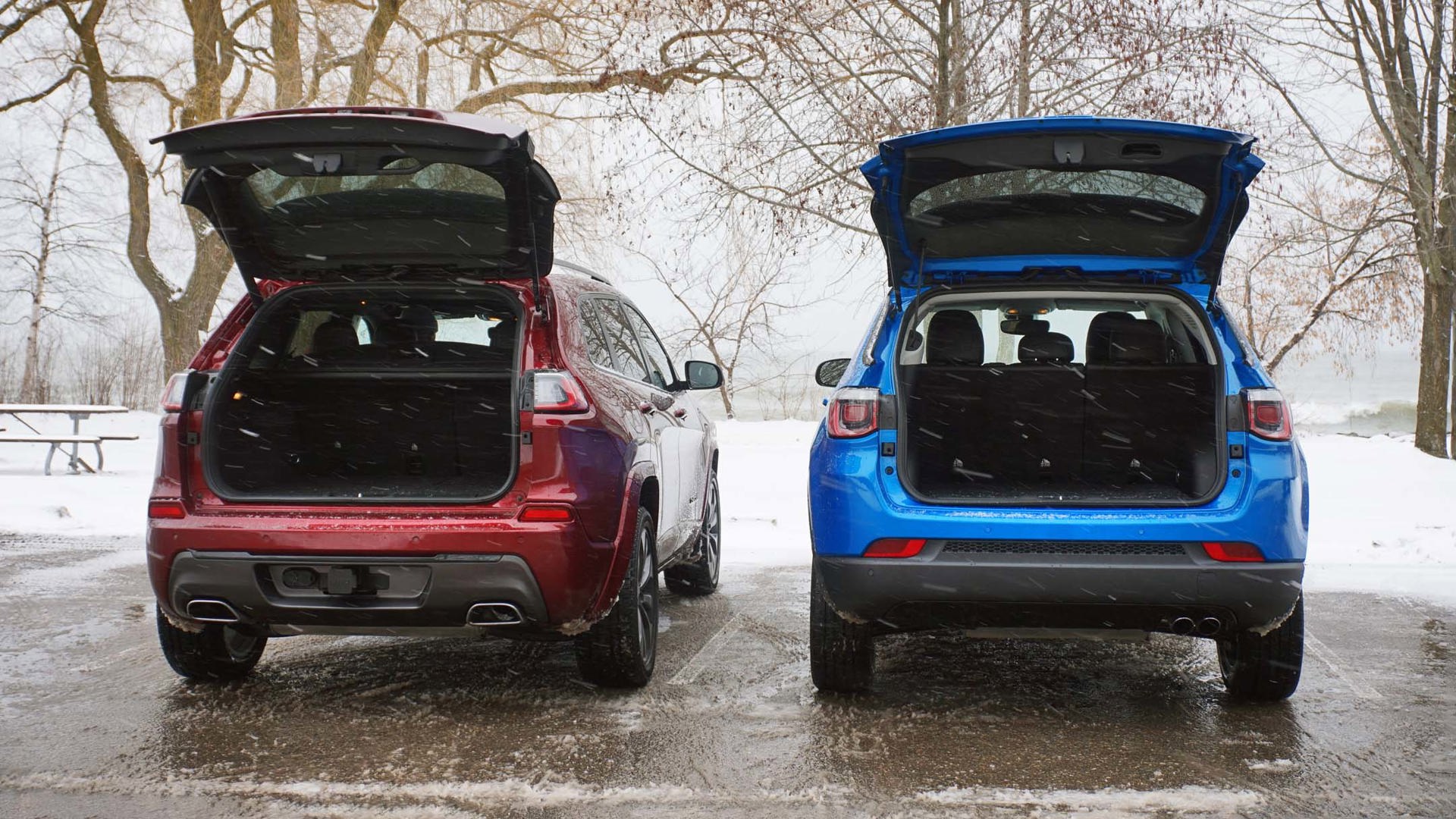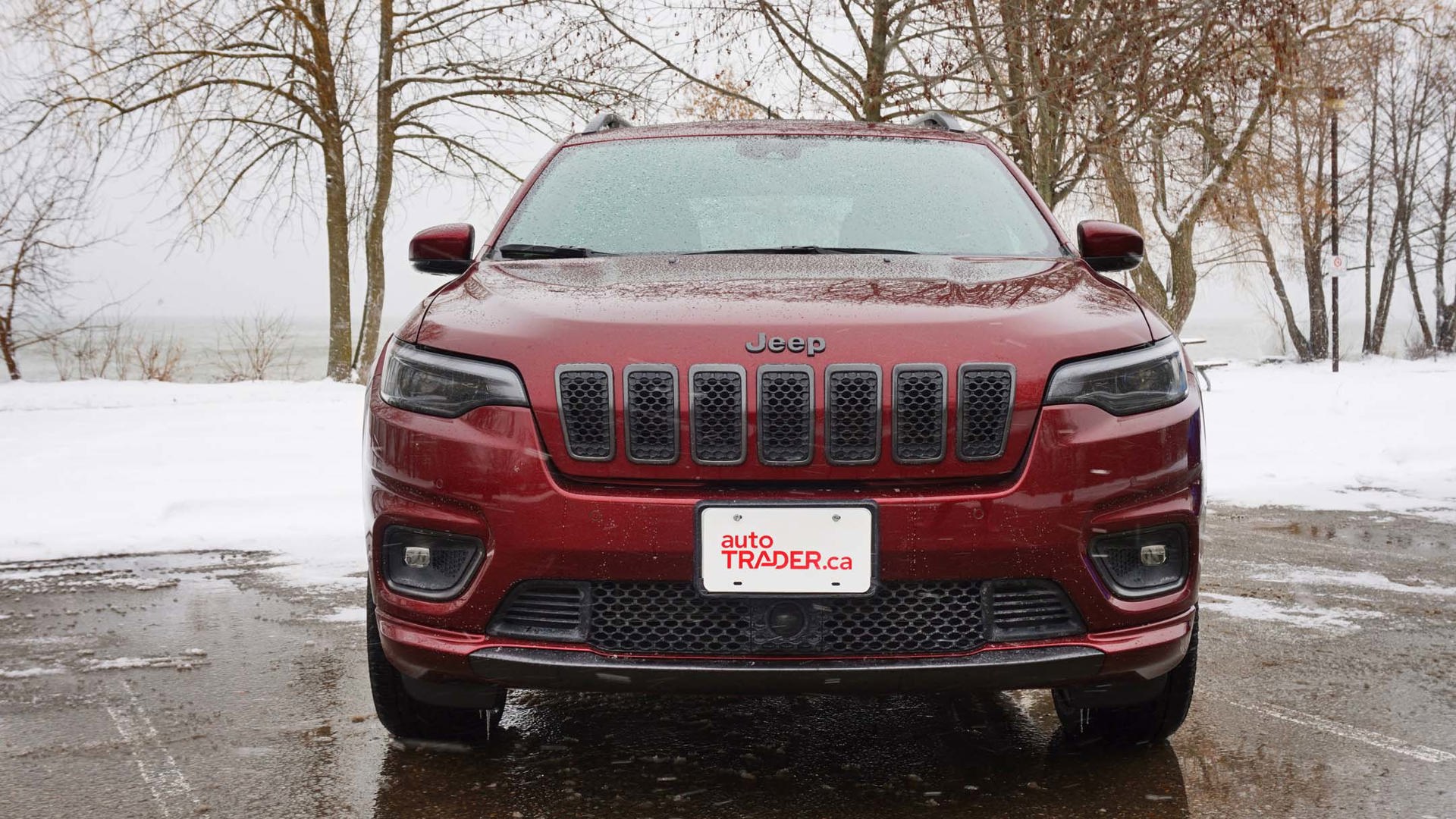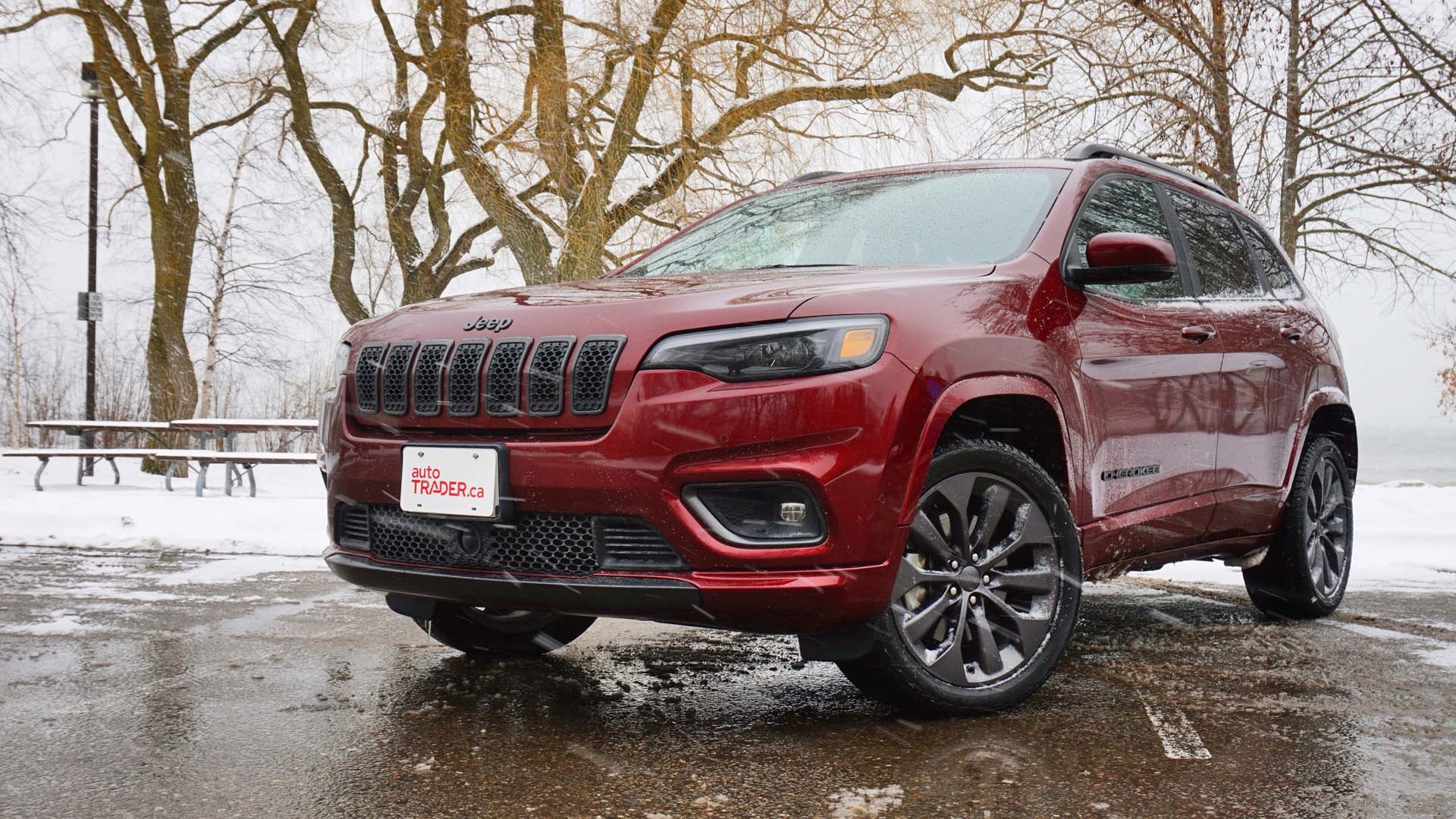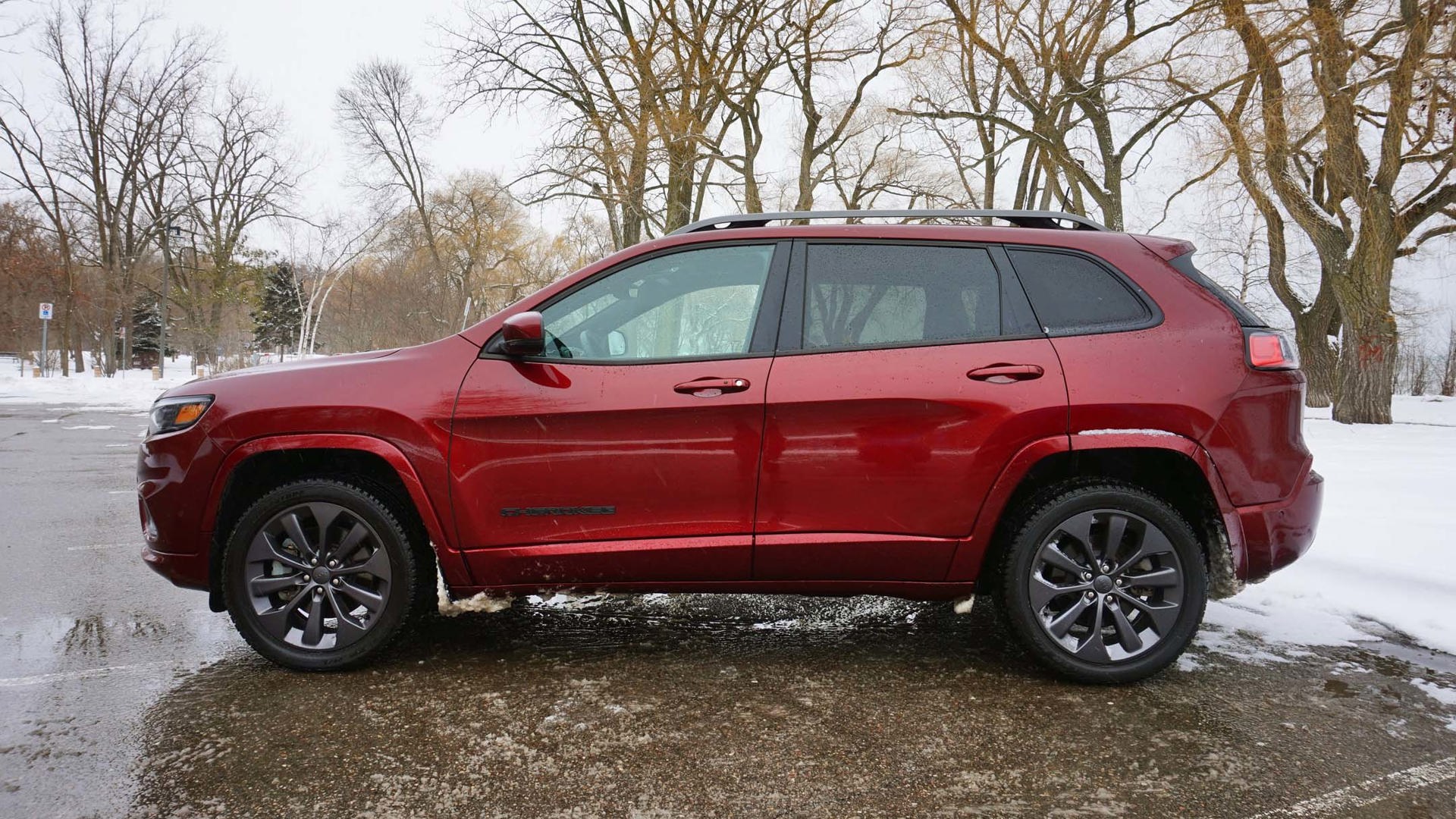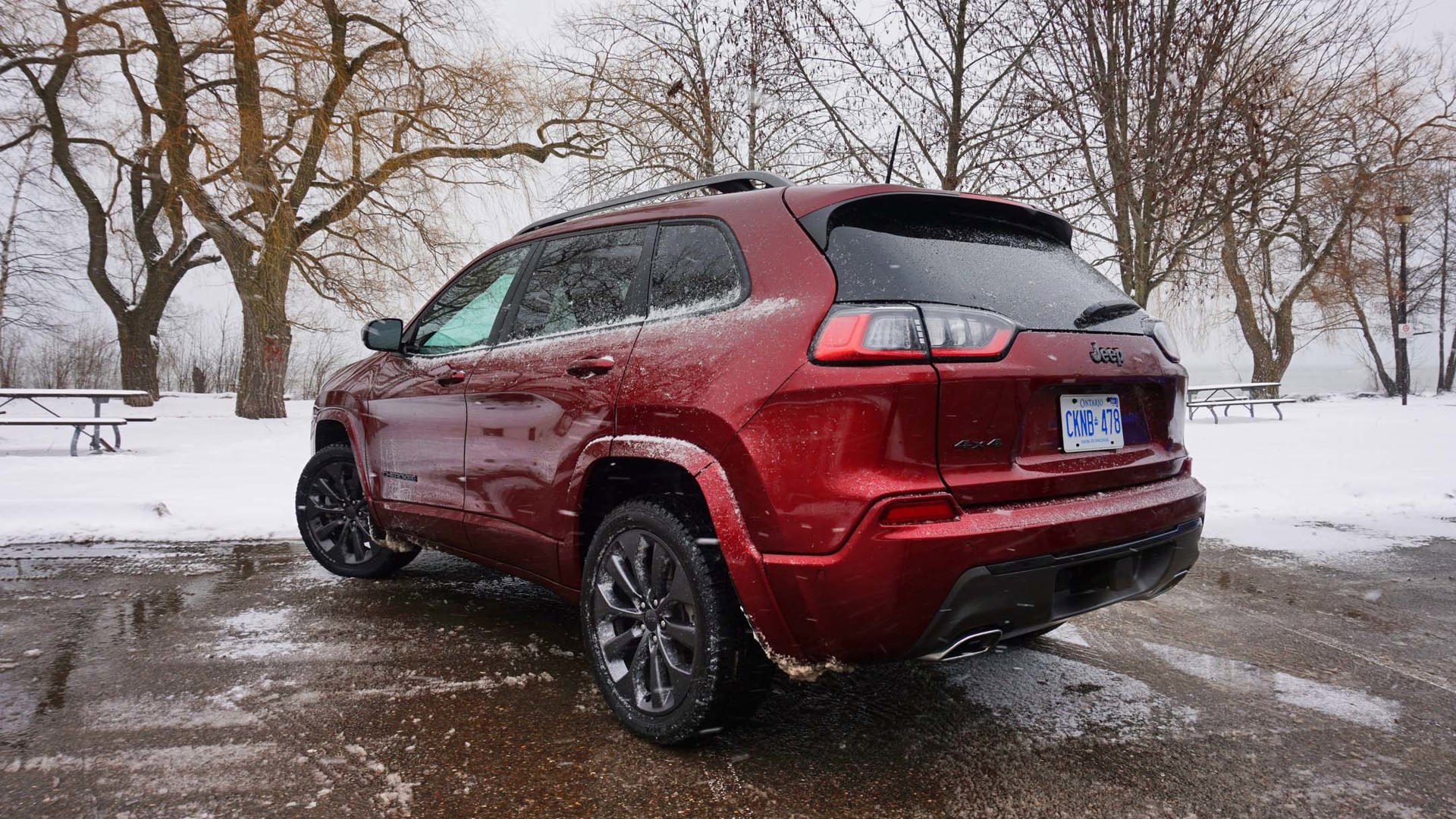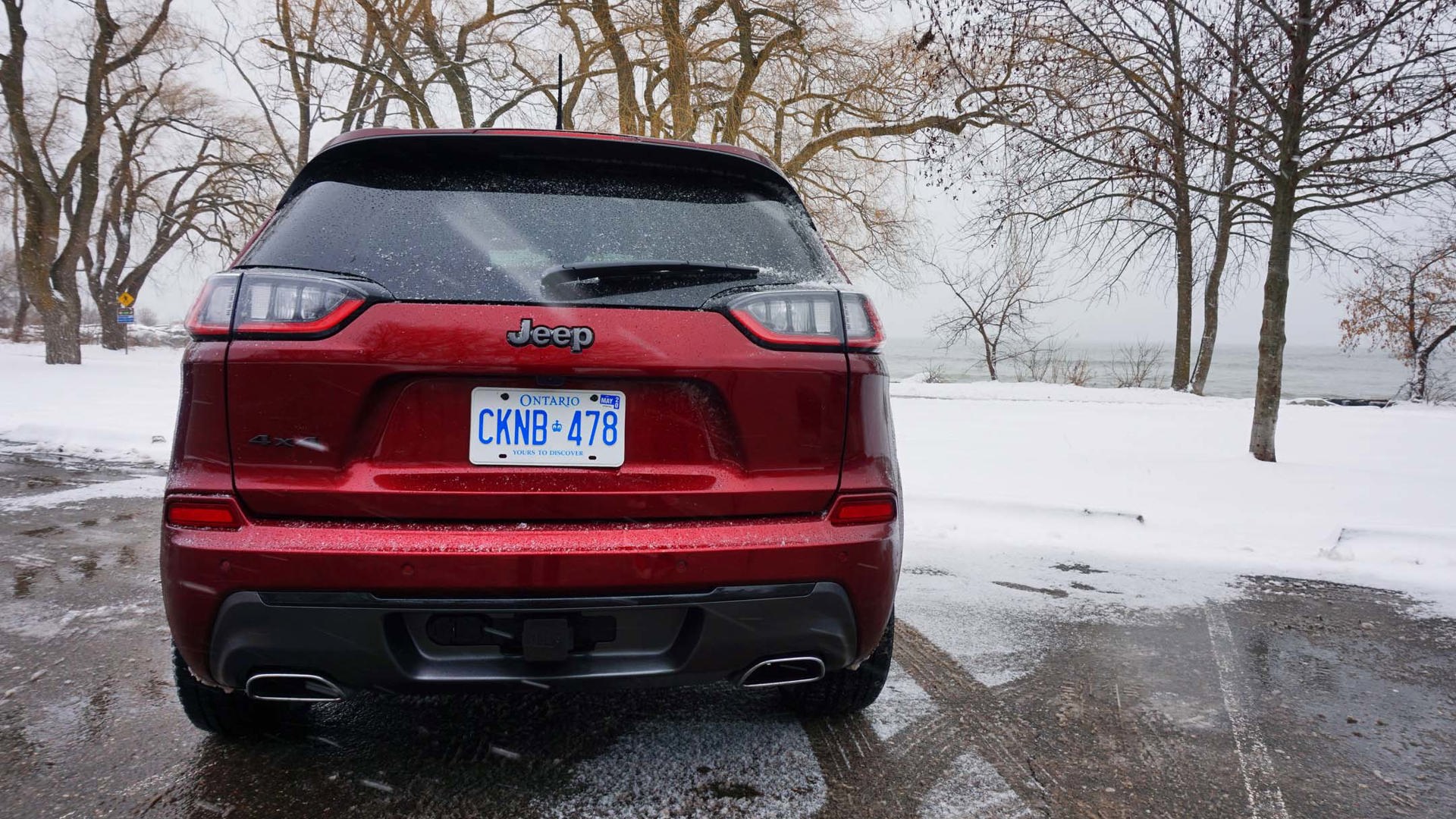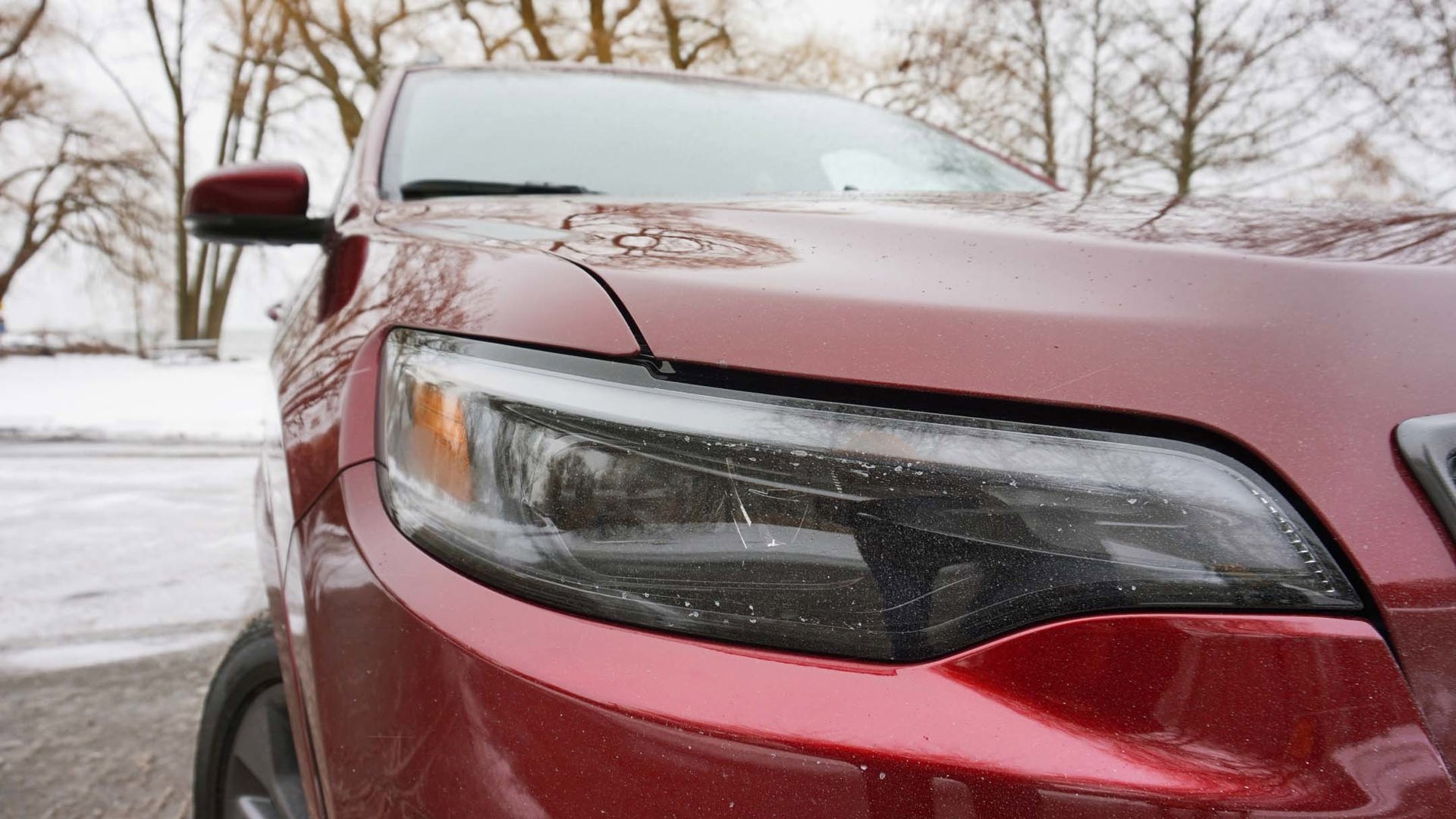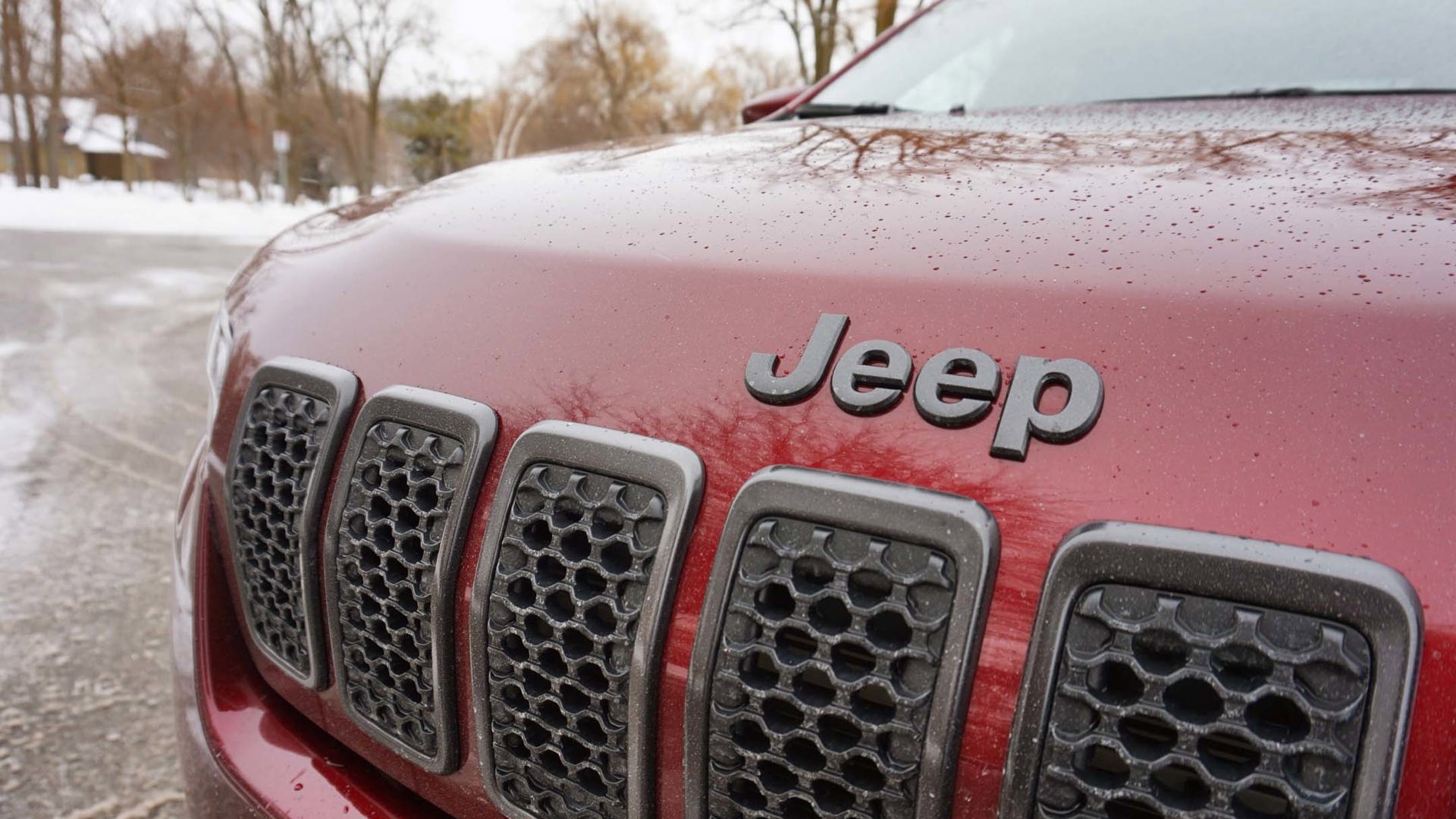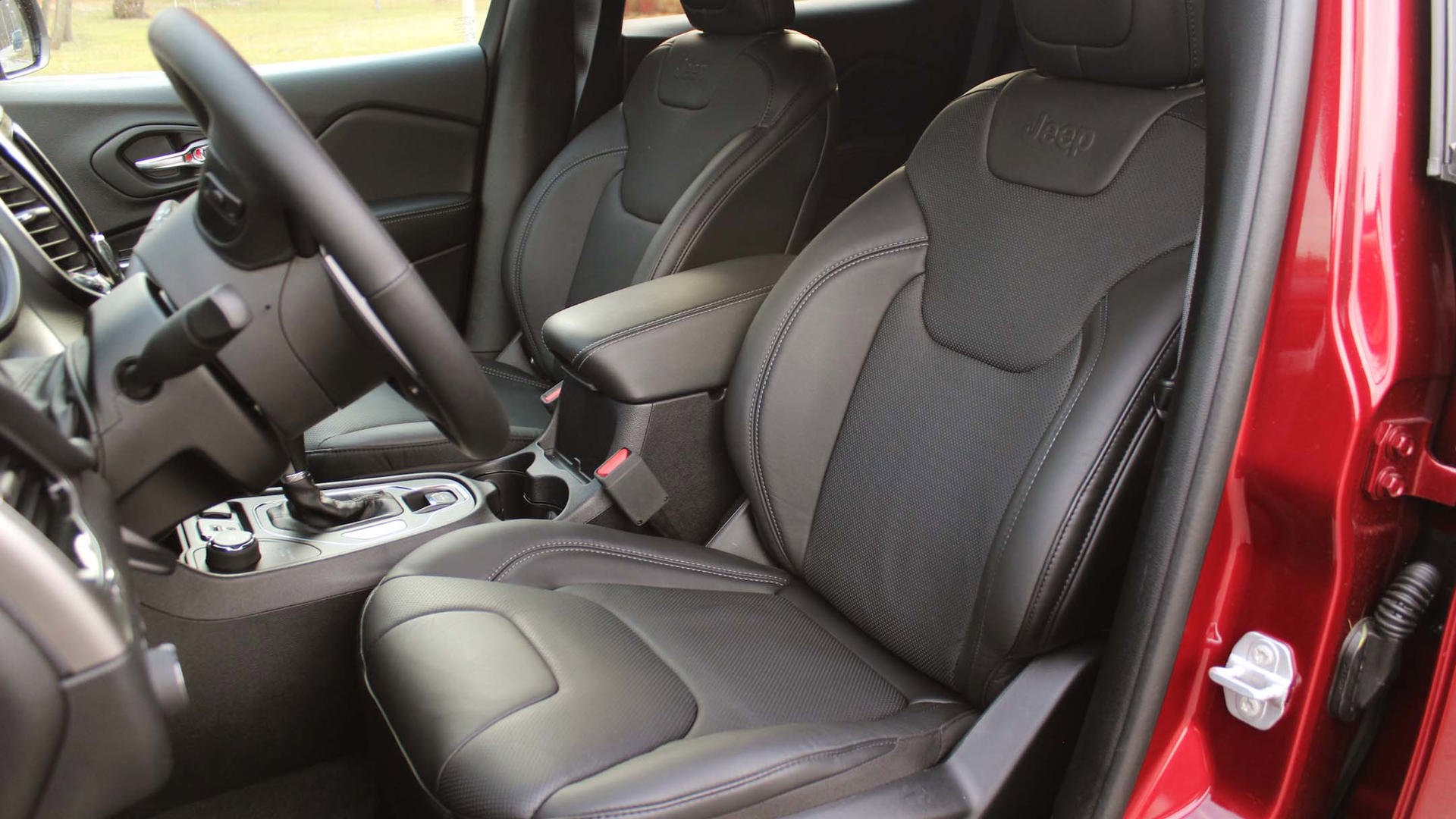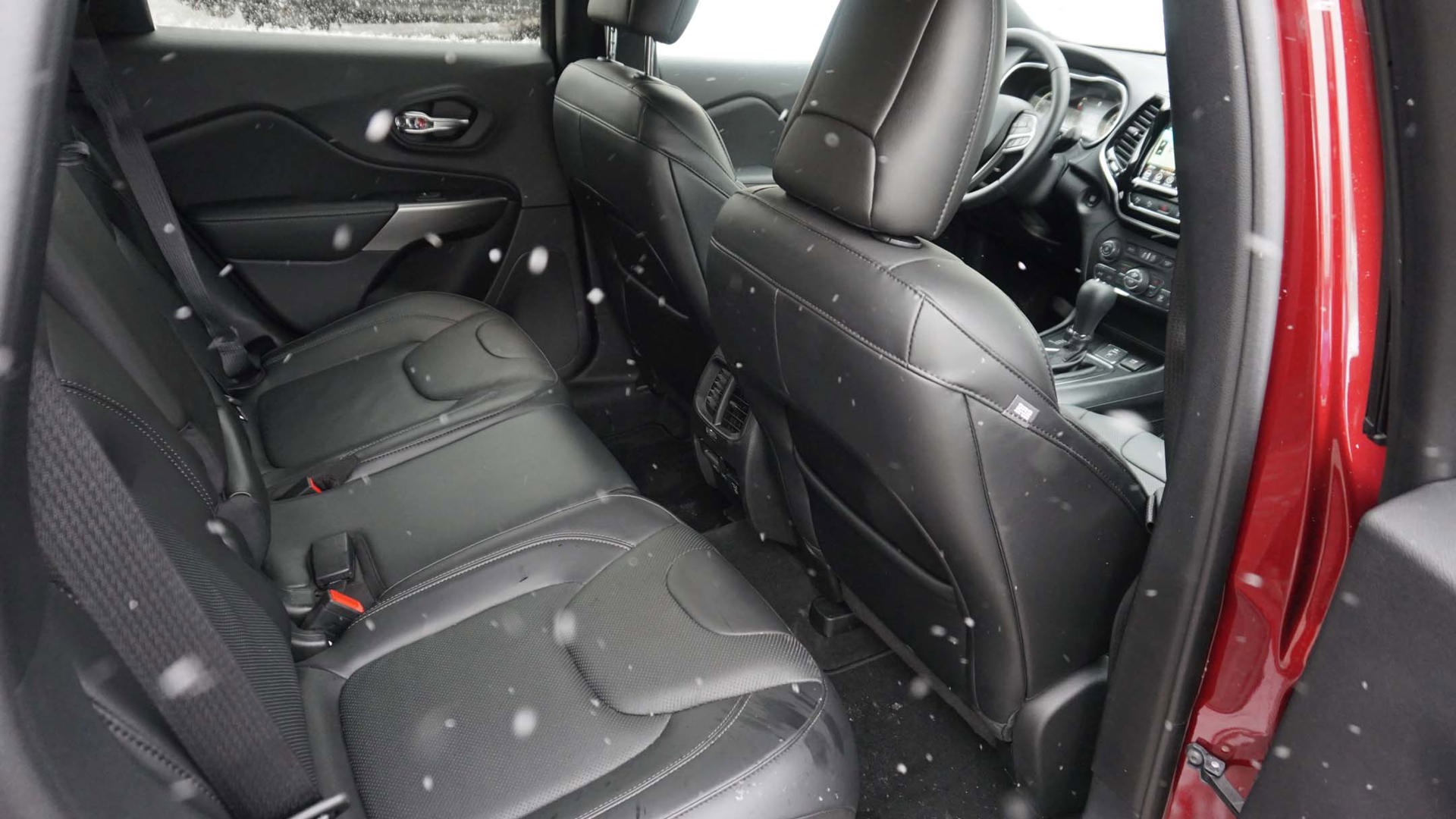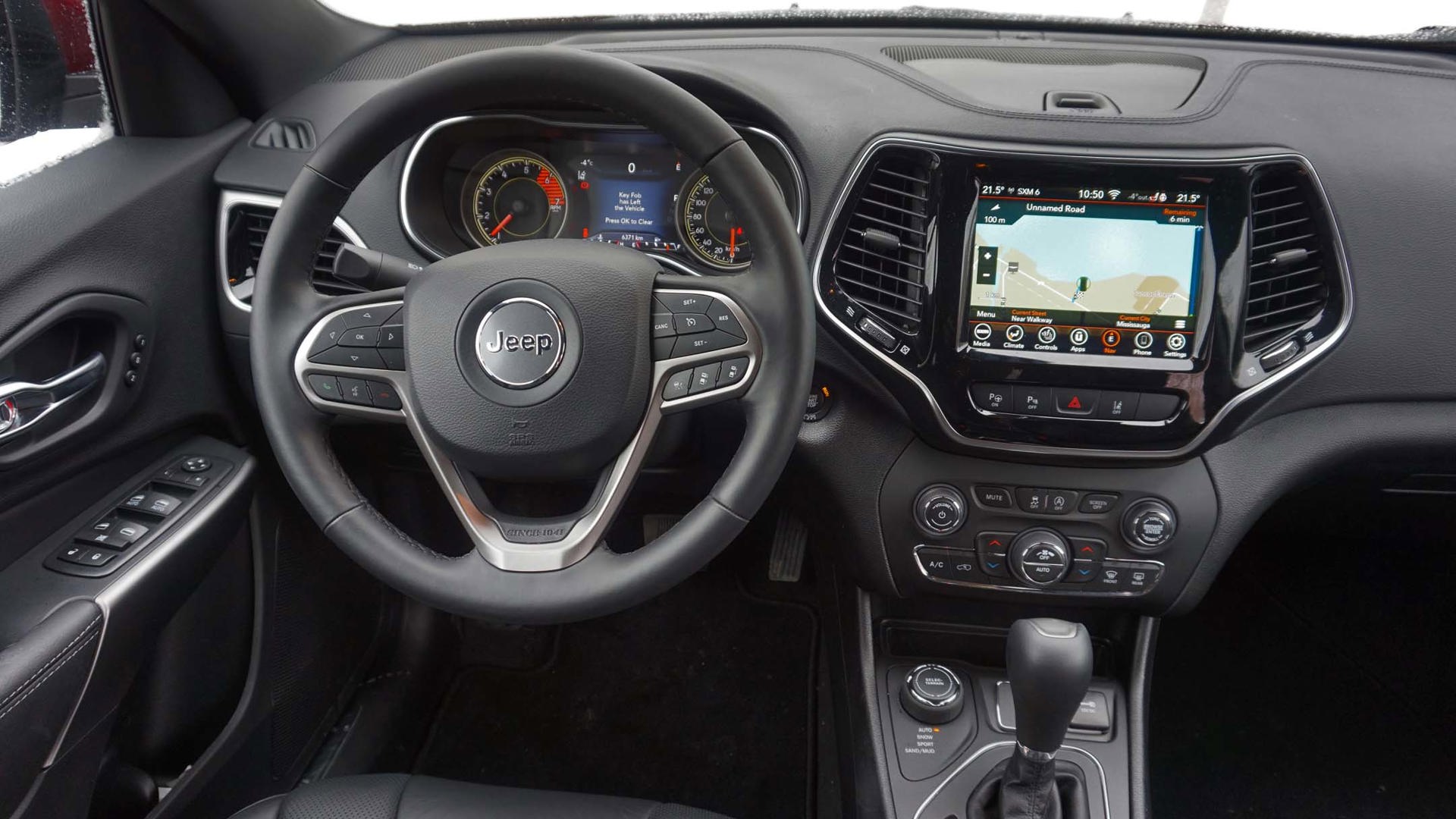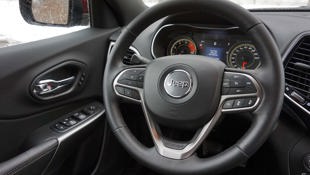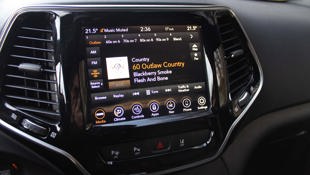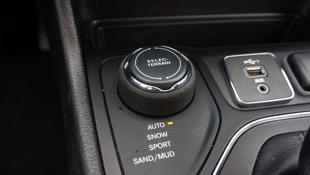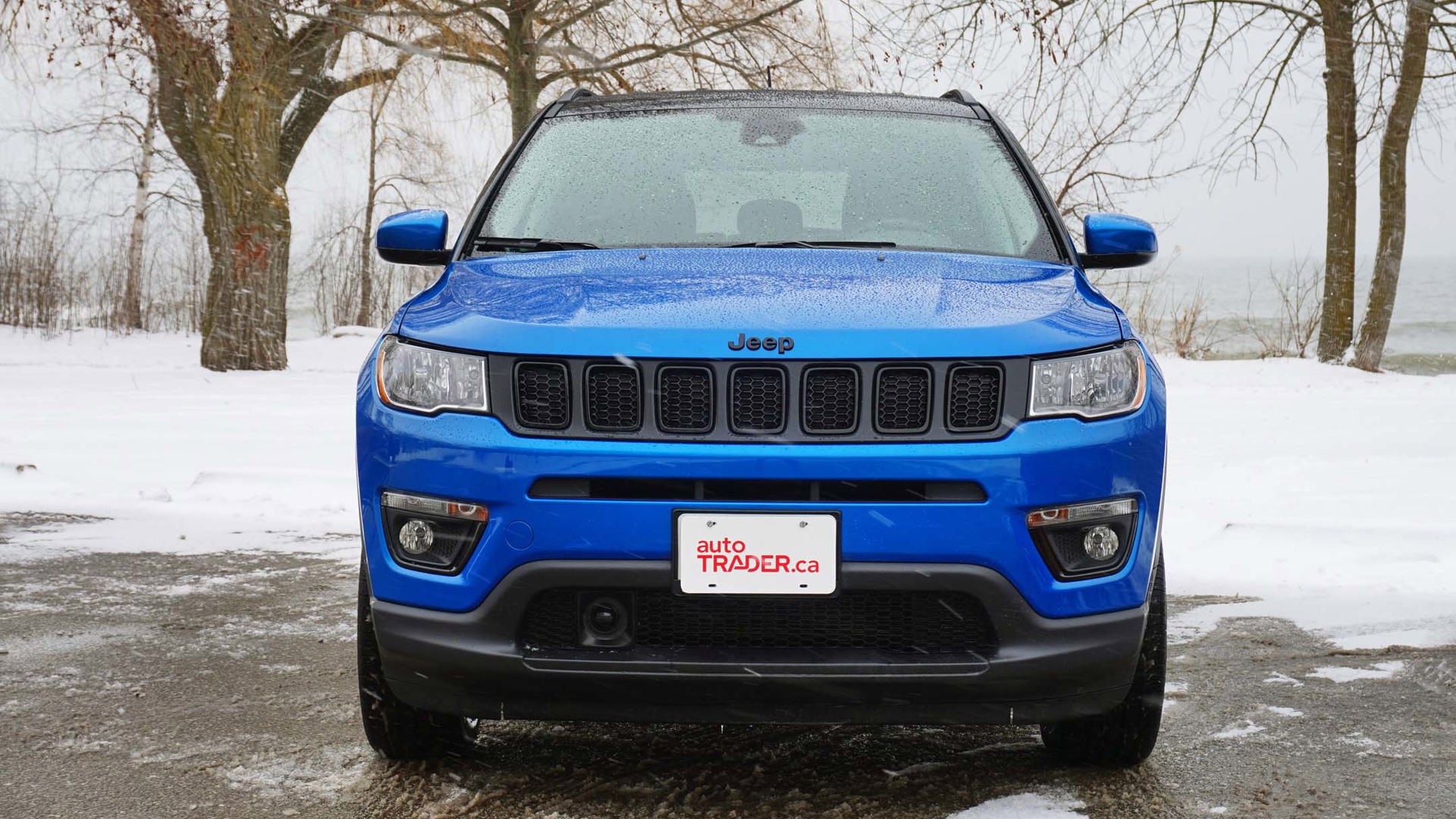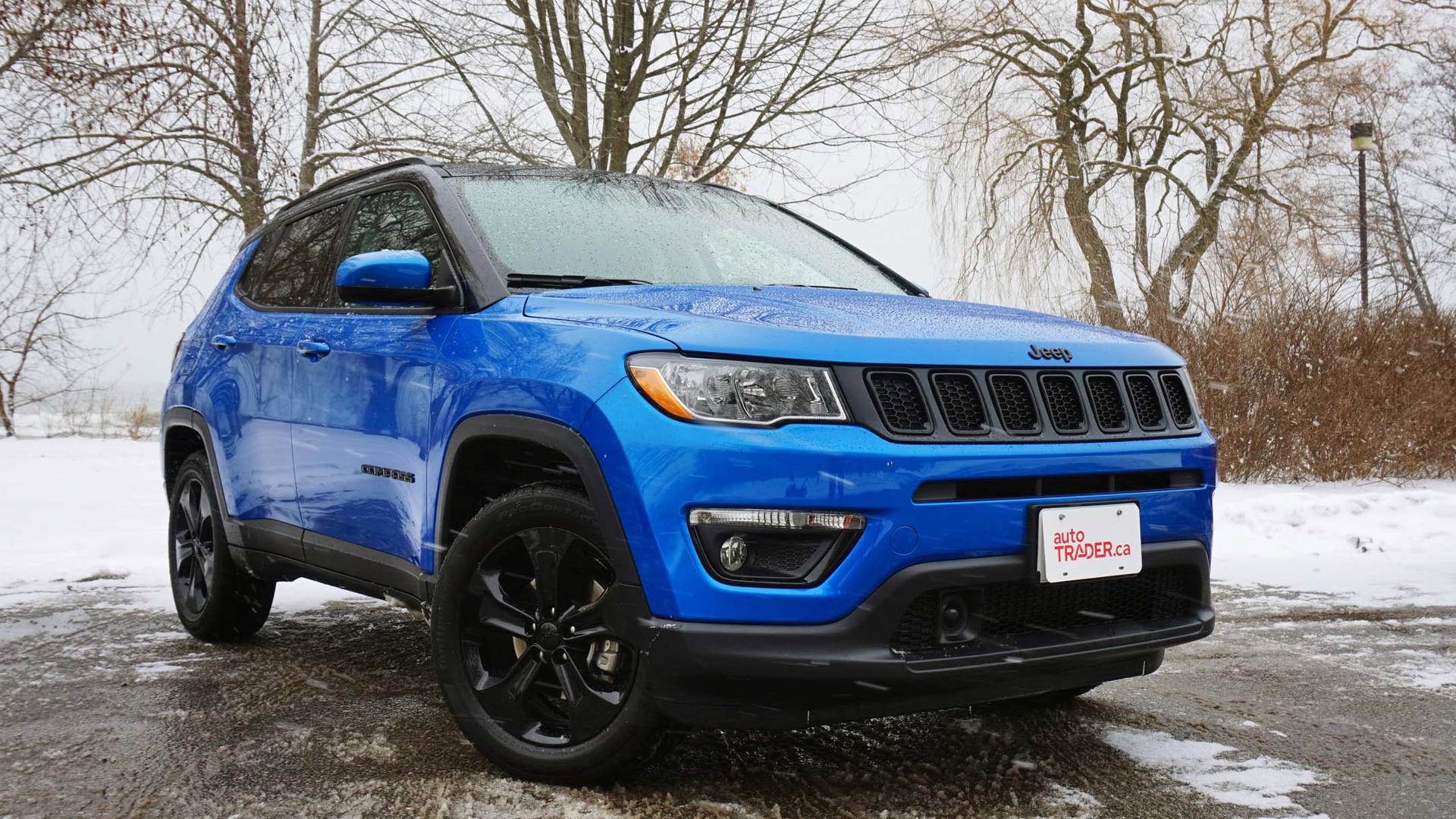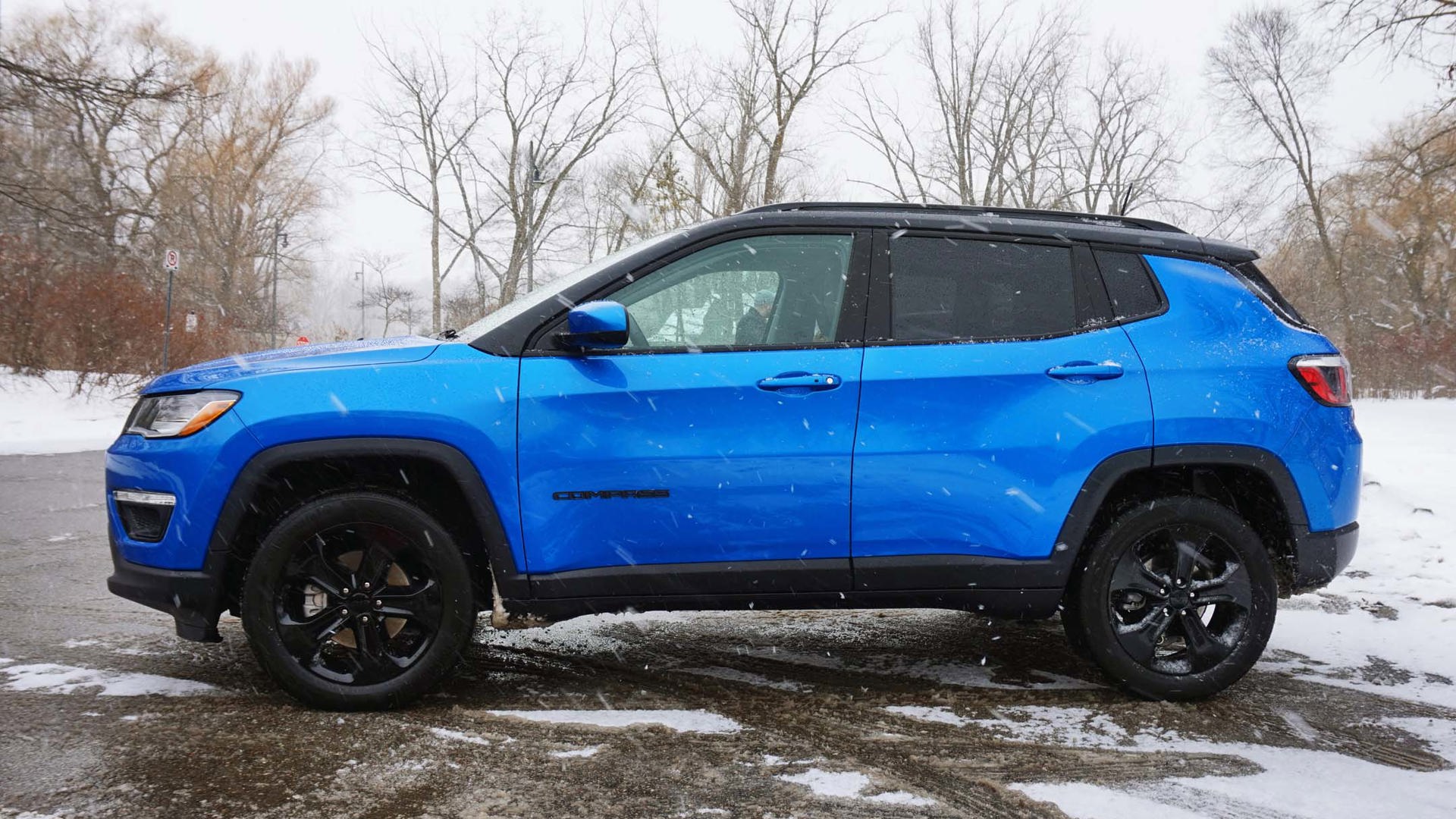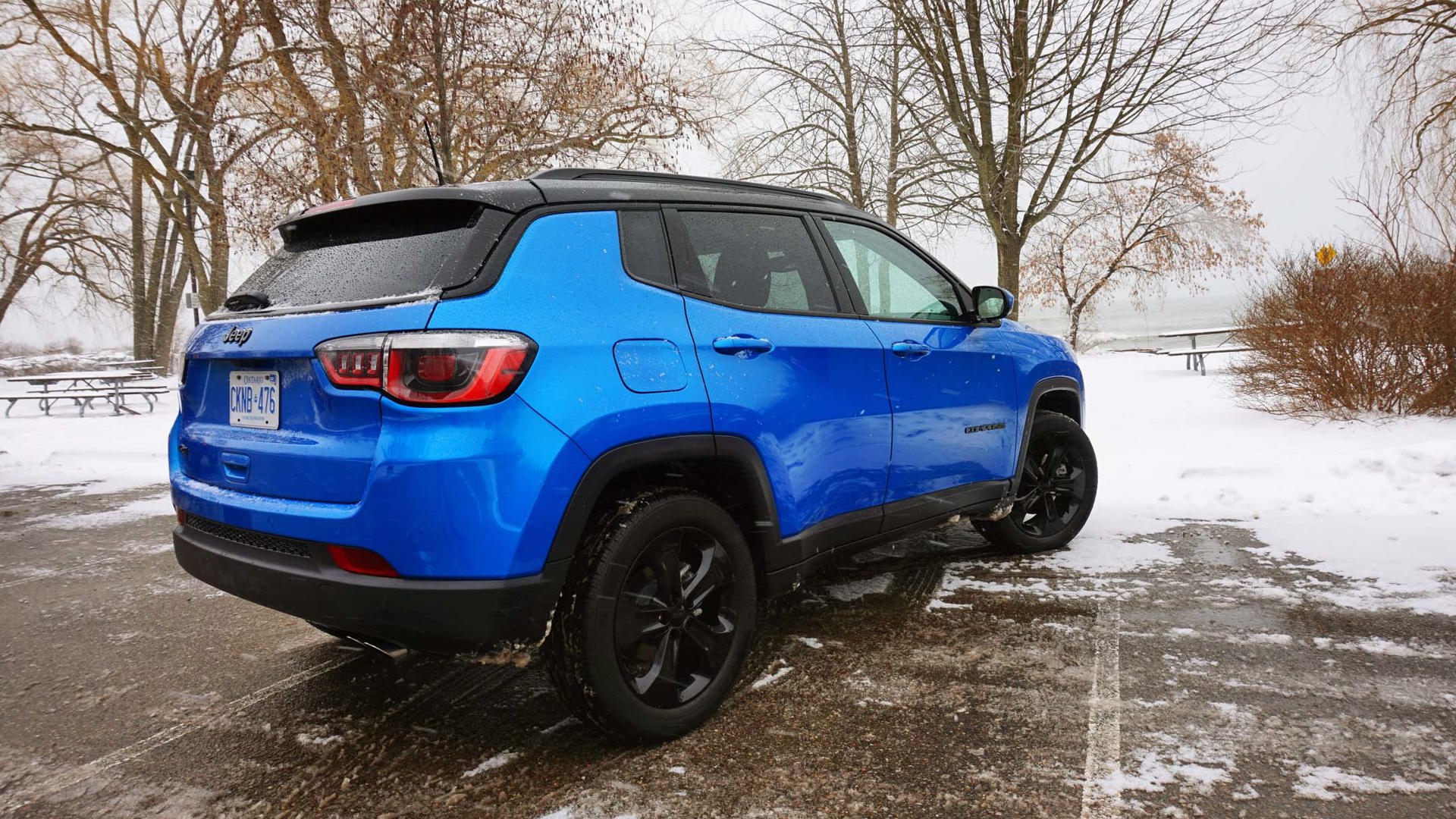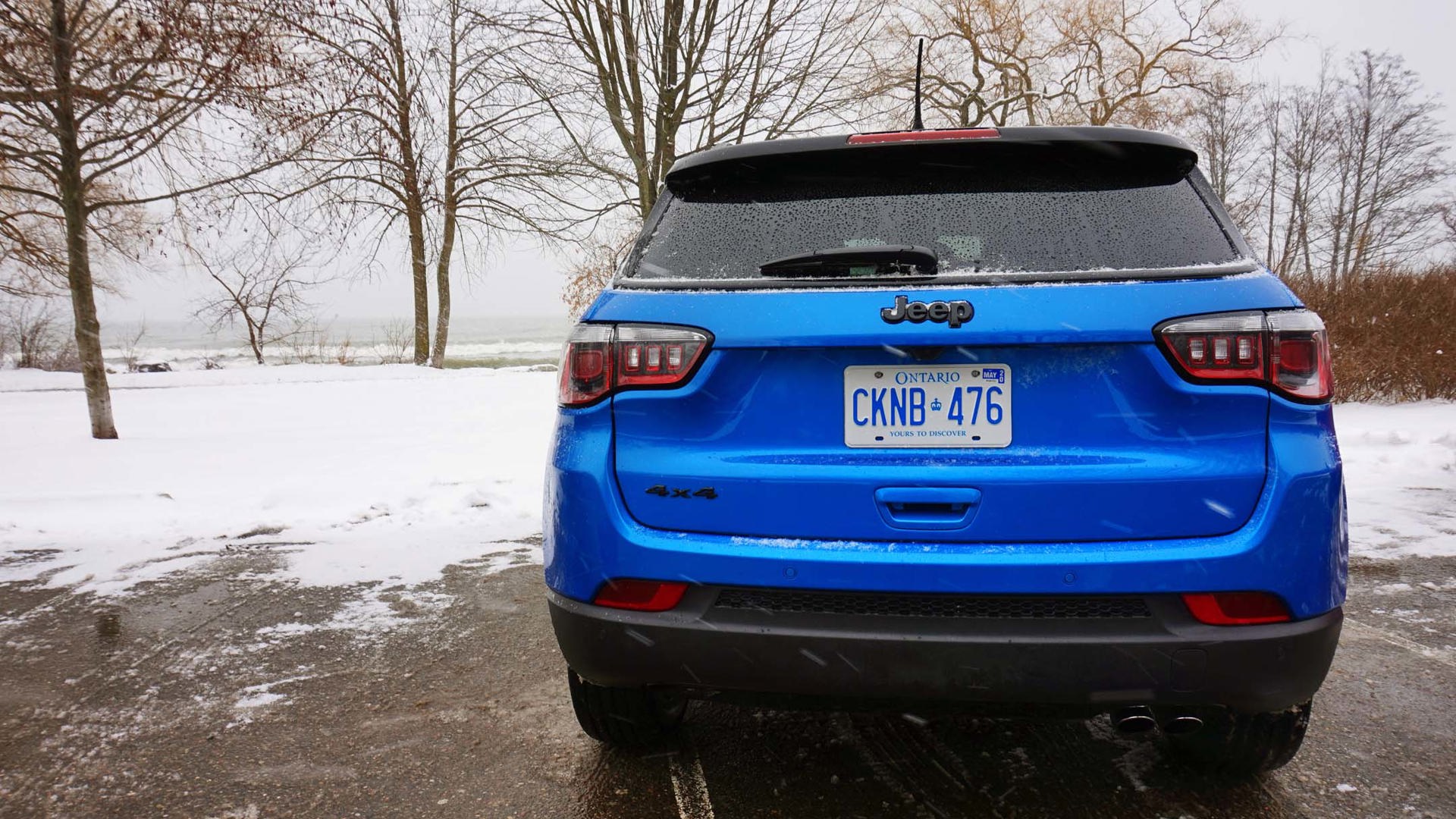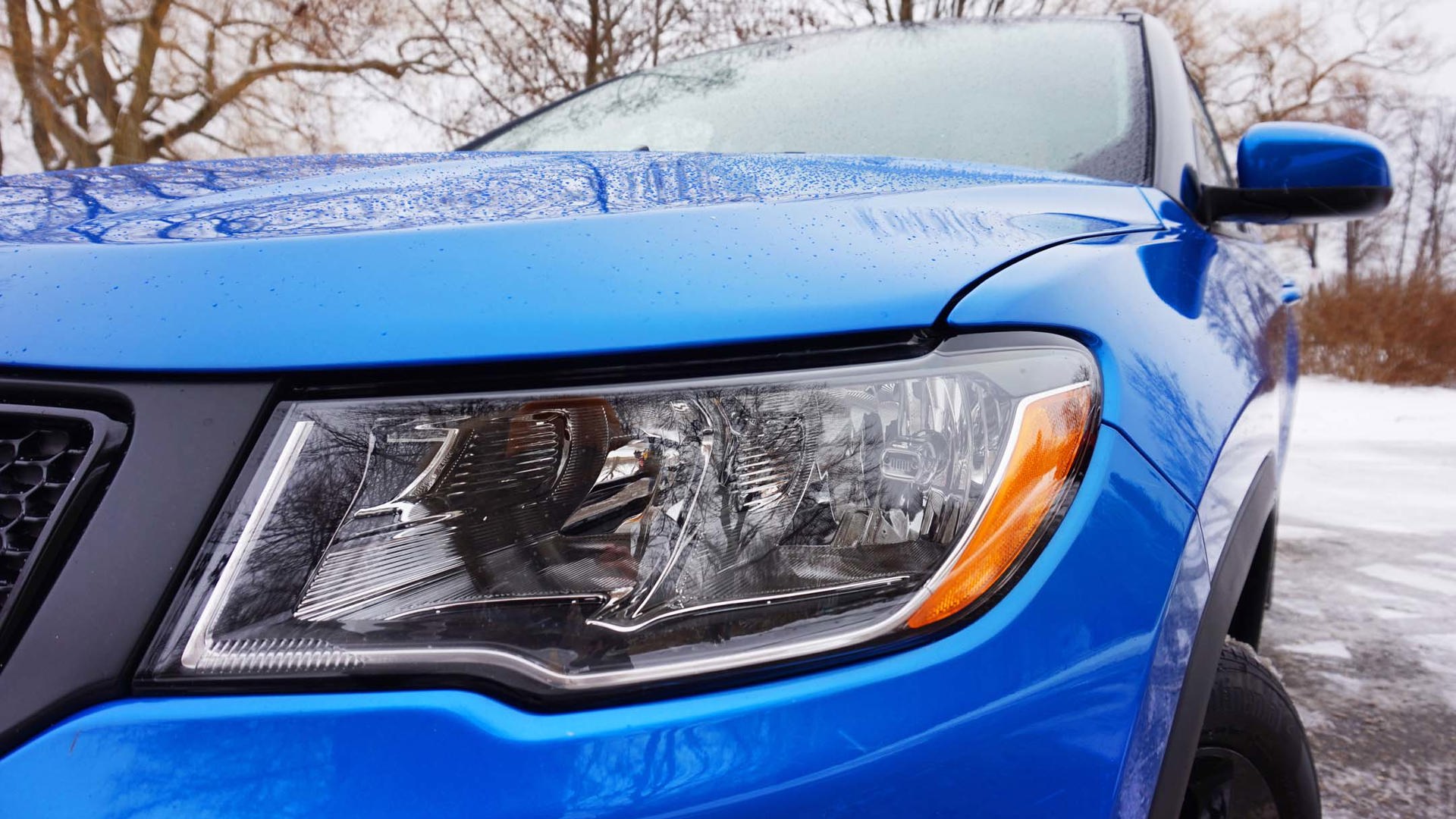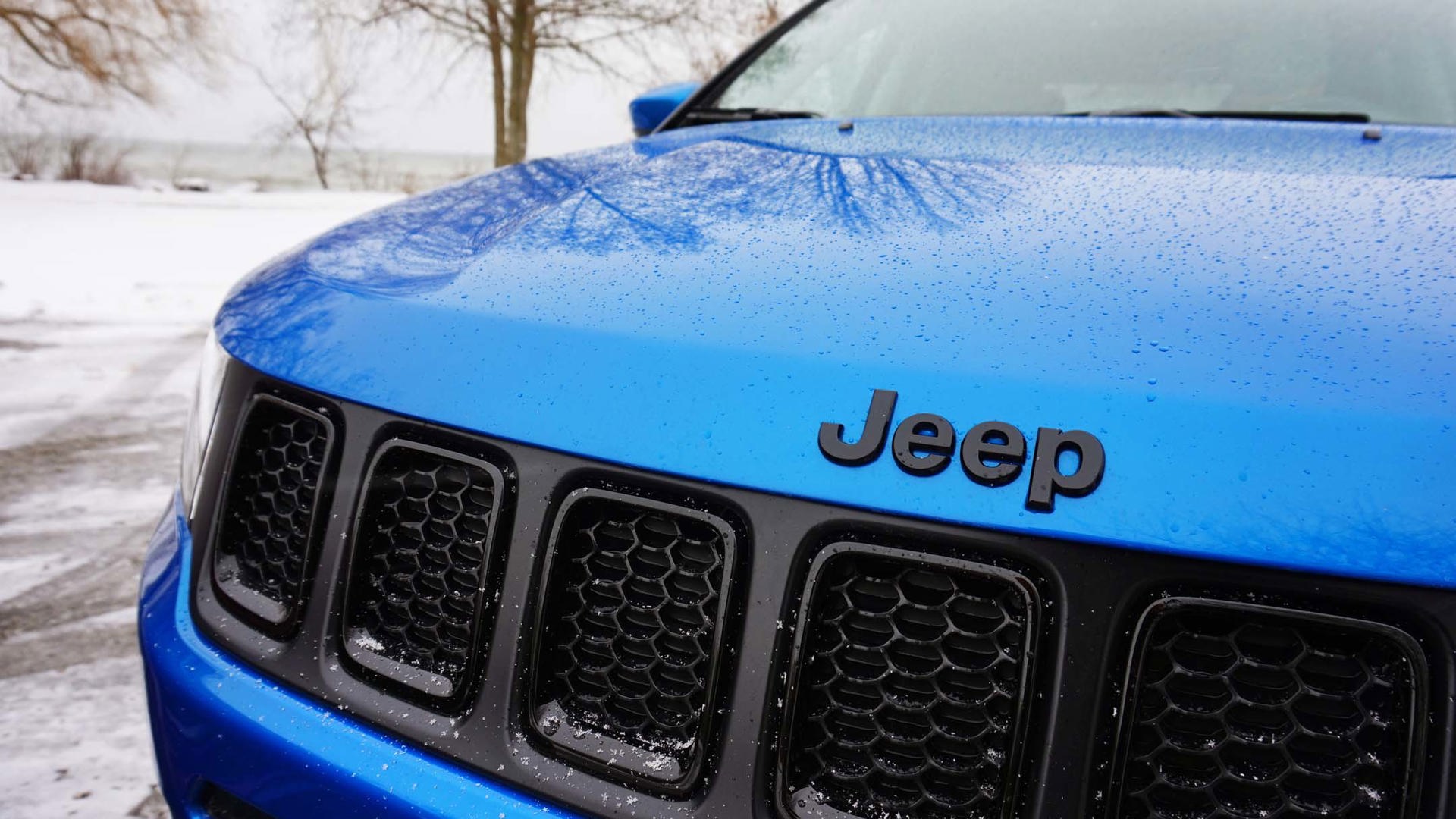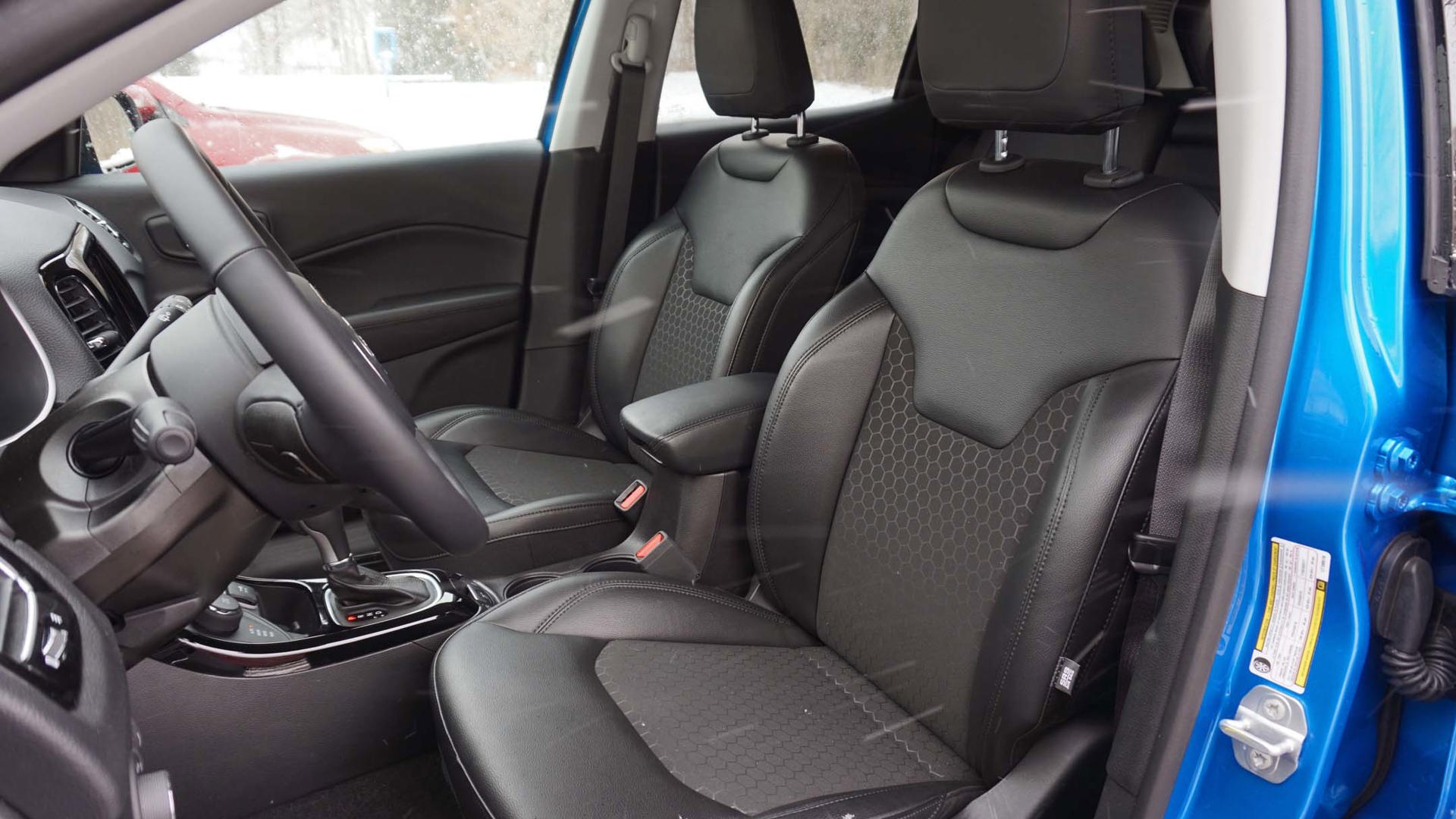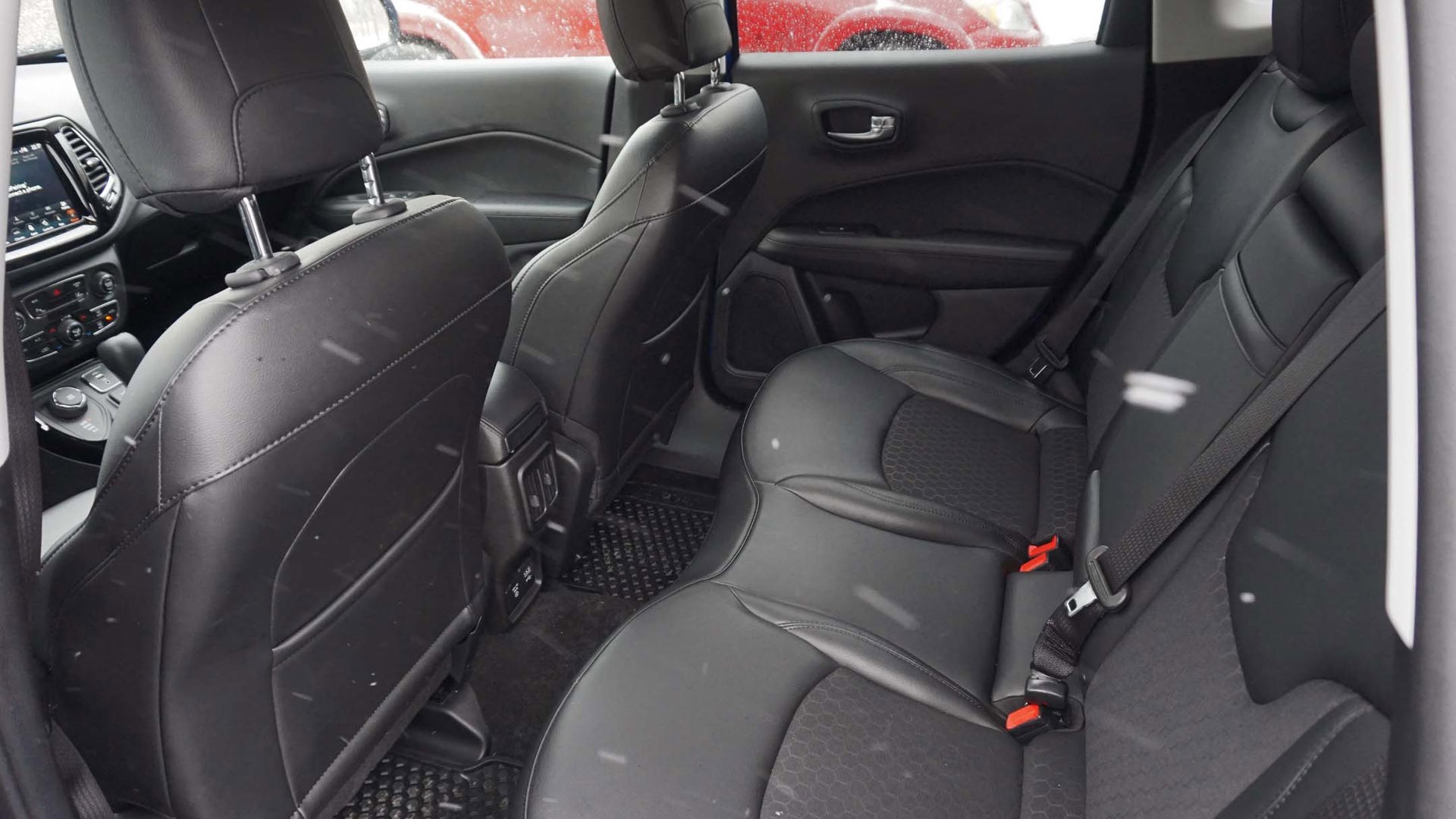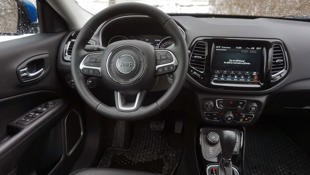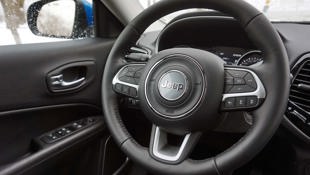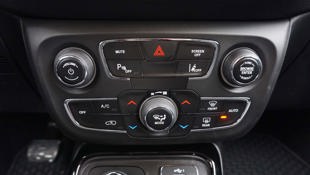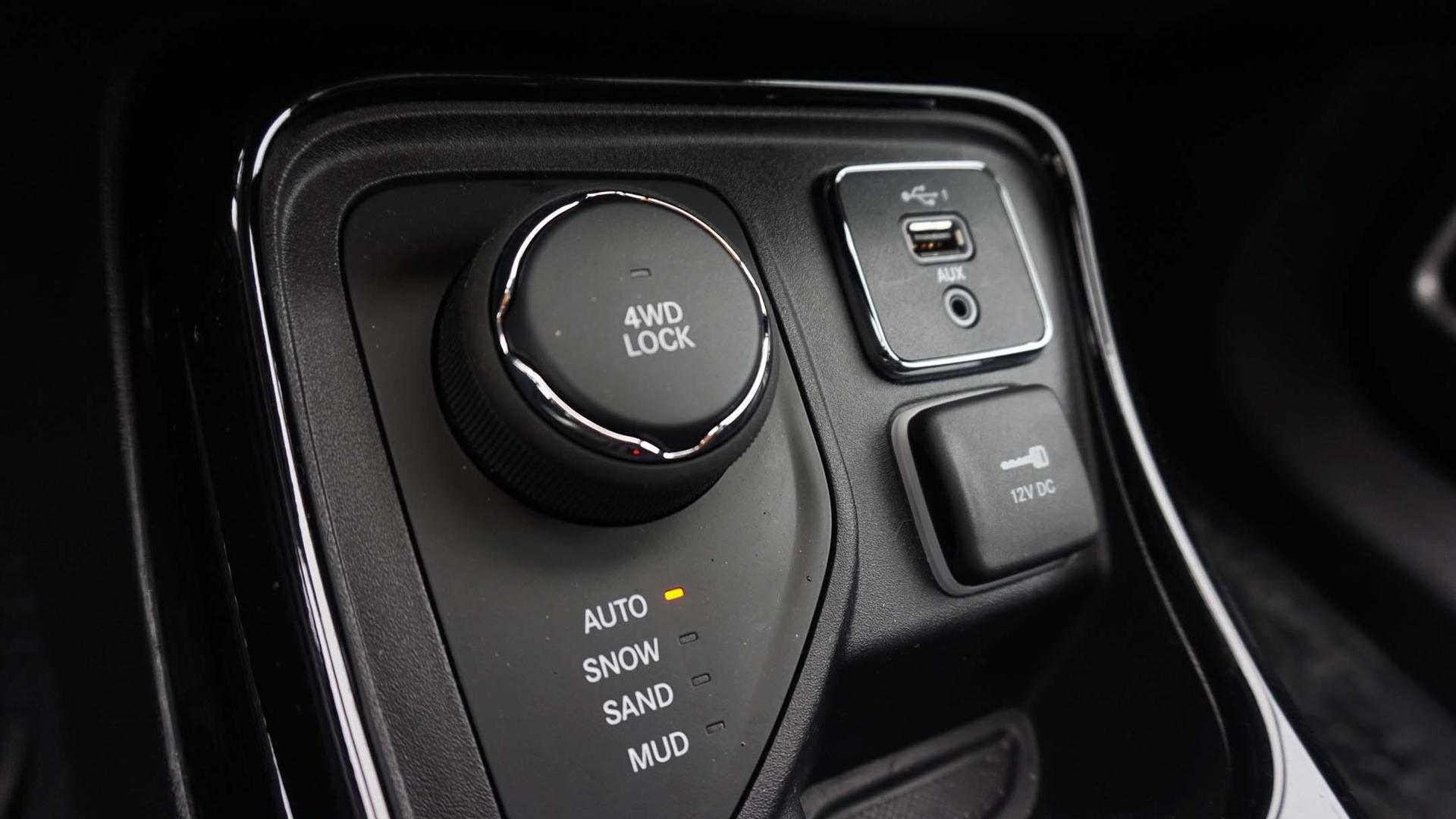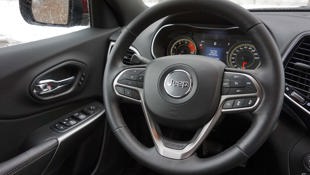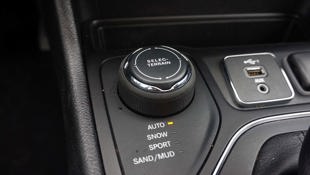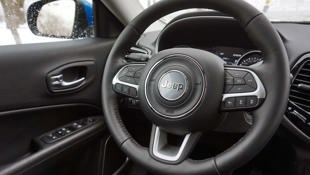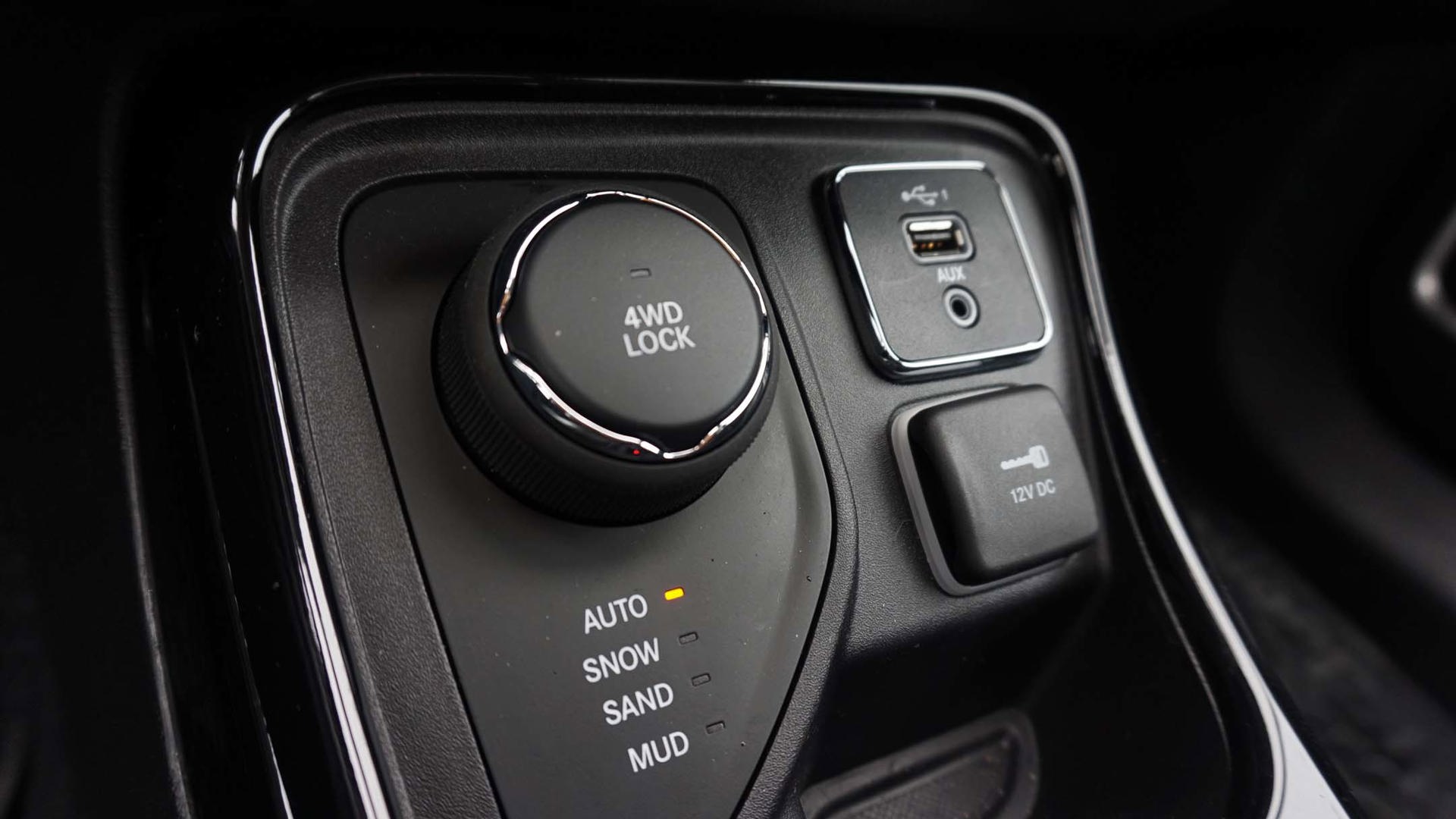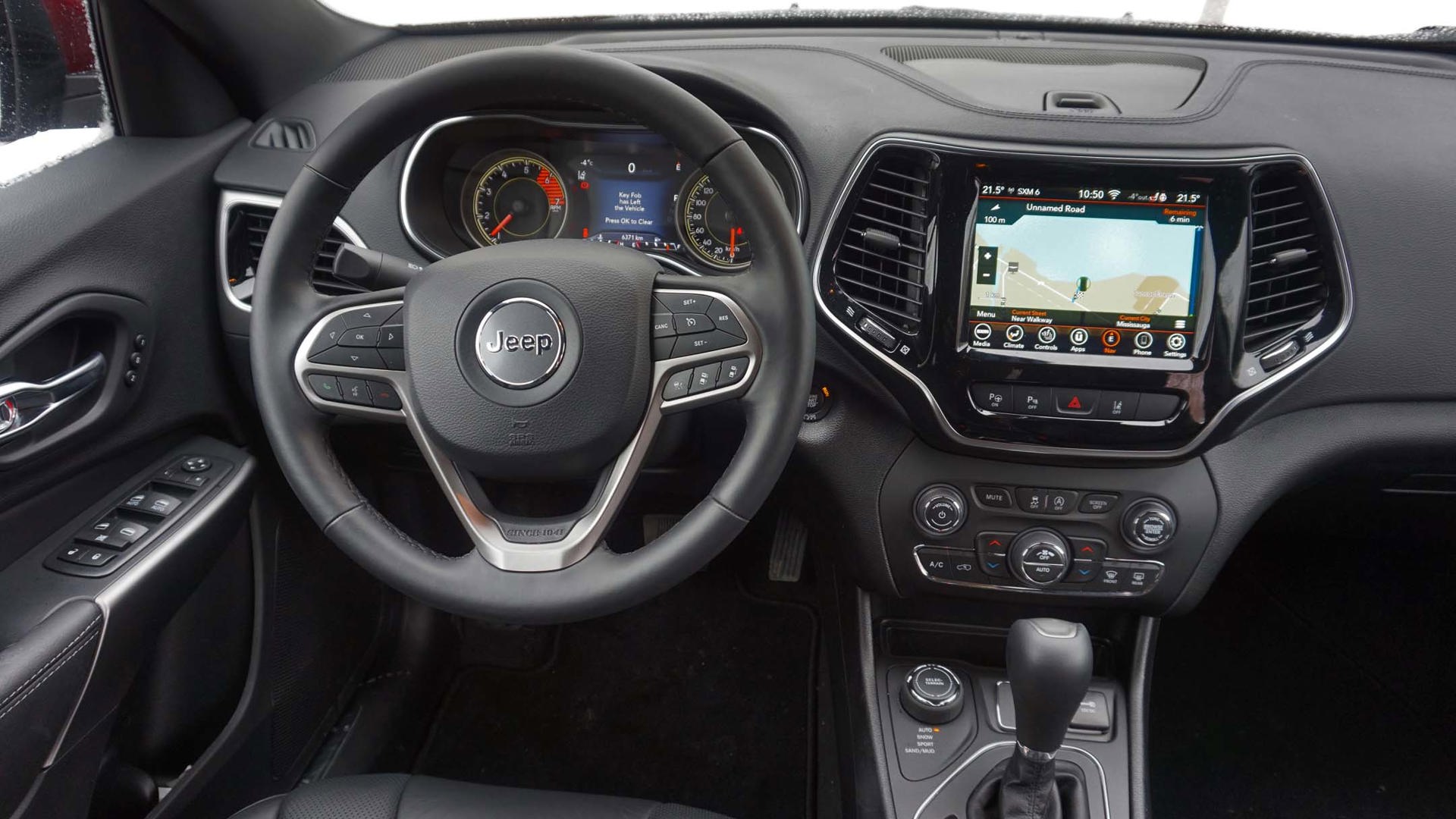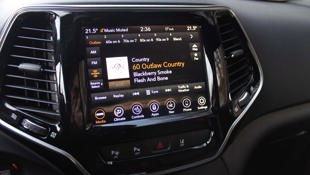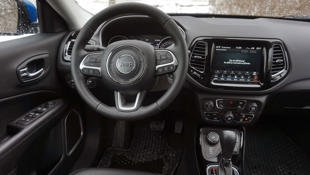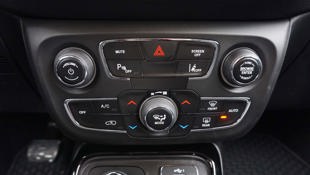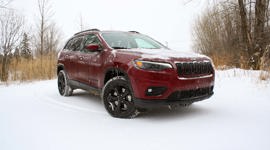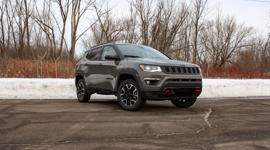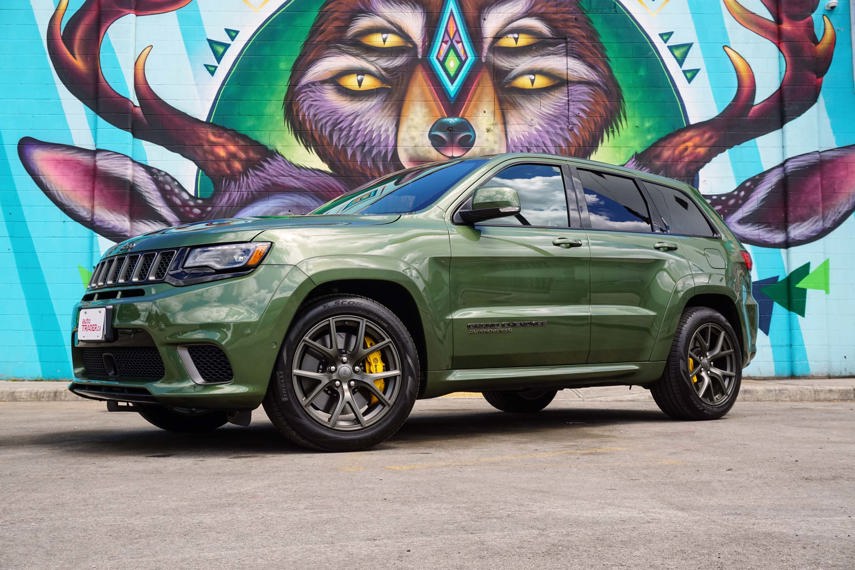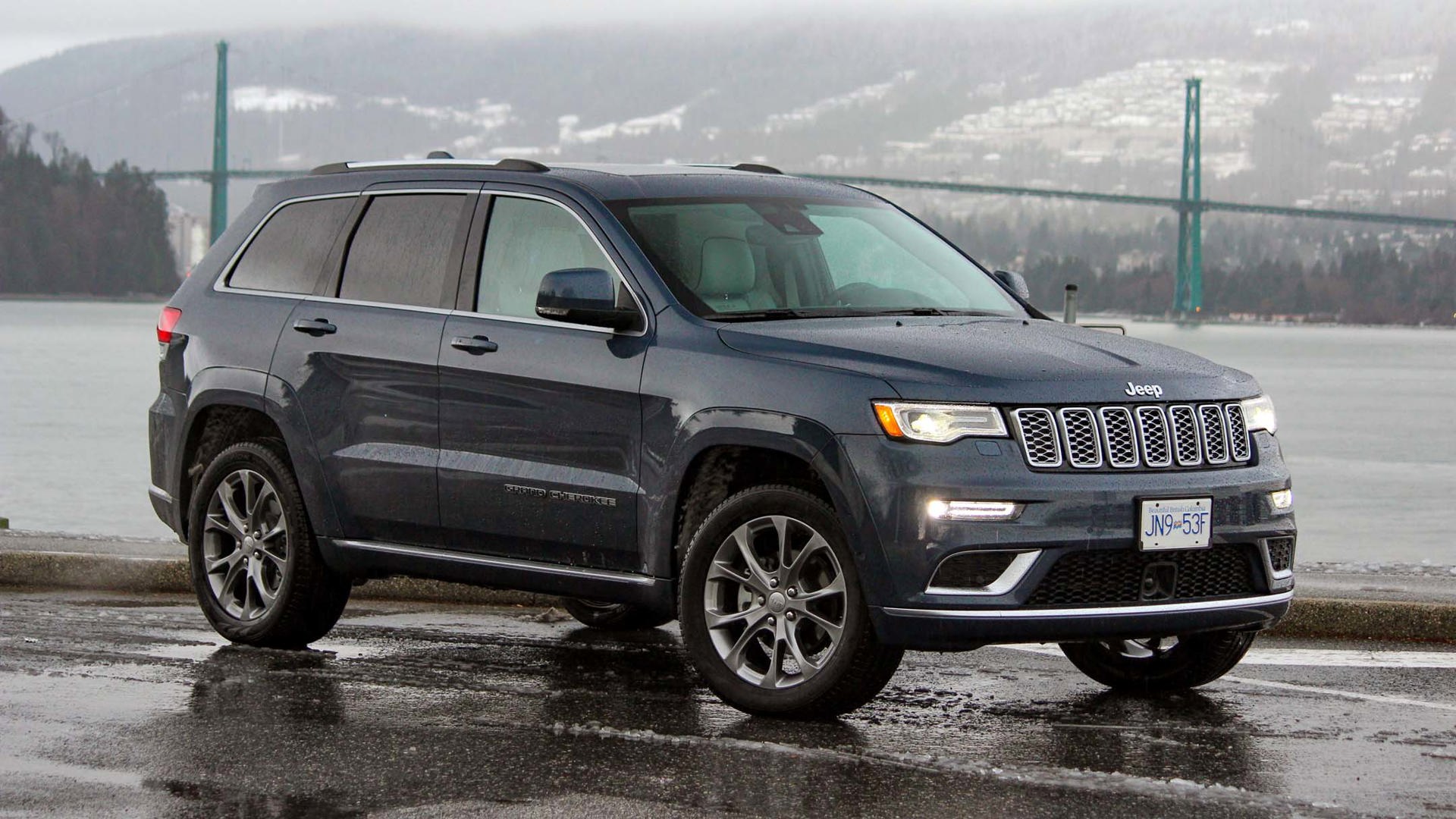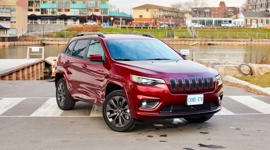Comparison Data
|
2020 Jeep Cherokee High Altitude 4x4
|
2020 Jeep Compass Altitude 4x4
|
|---|---|
|
Engine Displacement
2.0L
|
2.4L
|
|
Engine Cylinders
I4
|
I4
|
|
Peak Horsepower
270 hp @ 5,250 rpm
|
180 hp @ 6,400 rpm
|
|
Peak Torque
295 lb-ft @ 3,000–4,500 rpm
|
175 lb-ft @ 3,900 rpm
|
|
Fuel Economy
11.2/8.0/9.8 L/100 km cty/hwy/cmb
|
10.8/7.8/9.5 L/100 km cty/hwy/cmb
|
|
Cargo Space
730/1,549 L seats down
|
770/1,693 L seats down
|
|
Base Price
$40,995
|
$32,940
|
|
A/C Tax
$100
|
$100
|
|
Destination Fee
$1,895
|
$1,895
|
|
Price as Tested
$51,260
|
$40,530
|
|
Optional Equipment
$8,270 – Velvet Red Pearl Paint, $100; High Altitude Package, $2,195; SafetyTec Group, $500; Technology Group, $995; Luxury Group, $1,295; Trailer Tow Group, $595; 2.0L Turbo Engine, $995; CommandView Panoramic Sunroof, $1,595
|
$5,595 — Laser Blue Pearl Paint, $100; Cold Weather Group, $995; Safety and Security Group, $895; Advanced Safety group, $995; Popular Equipment Group, $795; Power Tailgate, $525; Compact Spare Tire, $295; 8.4-inch Uconnect 4C w/Nav., $995
|
For a brand that prides itself on its SUV virtuosity, there’s a bit of a logjam at the core of Jeep’s lineup.
That’s particularly true of the Cherokee and Compass, two not-so-different takes on small sport utilities. Both tout two rows of seats and good on-road comfort, competing directly with the likes of everything from the Chevrolet Equinox to the Subaru Forester – as well as with each other. Not much separates the pair dimensionally, especially on the inside, and they even look strikingly similar these days. But looks can be deceiving, and lining the pair up side by side reveals some surprising differences.
Styling
A hearty 10 years on the market for the Jeep Grand Cherokee has done nothing to diminish its place as one of the more stylish two-row SUVs on the market, and the brand was wise to pass those familial looks down the lineup.
The Compass in particular is styled as a shrunken version of its larger sibling, sharing plenty of design cues that, to squinting eyes, makes it difficult to distinguish from afar. Step inside and it’s a different story, with a far more youthful vibe than what’s in the upmarket Grand Cherokee. The Compass instead gets a hexagonal theme that, in the case of the Altitude trim tested here, continues across the fabric seat inserts.
Shifting to the Cherokee, the interior is slightly more moderate in its styling, with an air of sophistication injected in the High Altitude model tested alongside the Compass. Here, it’s the leather that’s the star of the show, with the perforated seating surfaces as nice to look at as they are to touch.
The Cherokee’s exterior design is far easier on the eyes than it once was, with the brand putting out to pasture the evil-eyed look of old for something far more traditional and more closely aligned with the Compass and Grand Cherokee. The result is a classier look overall, with styling that’s much easier to live with than before.
Compass: 8; Cherokee: 8
Practicality
The Cherokee is the larger of the two vehicles, measuring 4,650 mm from bumper to bumper compared to 4,394 mm. Much of that additional length is found ahead of the passenger cell, however, making more room for the available V6 engine under the hood – but more on that later. When it comes to space inside then, there’s virtually no discernable difference between them outside of some extra shoulder room in the Cherokee. In fact, looking beyond the spec sheets, it’s the Compass that’s the outright winner of the space race.
Some of the advantages found in the Compass come down to how the testers here are optioned; headroom, for example, is superior in the smaller of the two, but that’s because it doesn’t have a sunroof. The Cherokee, meanwhile, is fitted with an available panoramic roof, which cuts into headroom significantly enough to affect taller occupants.
With less shoulder room, the Compass is penalized by a smaller centre console and armrest storage bin. Where the Cherokee has more space for stuff like keys and cellphones, the Compass is rather limited in that regard. That’s particularly problematic when using the USB port up front, with no corresponding space to stick a phone on the go.
Sliding into the second row, the Compass can easily accommodate taller occupants, with more legroom in practice than the Cherokee has on paper. Jeep lists legroom in the Compass at 973 mm compared to 1,023 mm in the Cherokee, but settling into the back seat brings with it more space in the former with the driver’s seat set up for your author’s 6-foot-3 frame.
Behind the tailgate, the Cherokee’s cargo area measures wider and longer than what’s in the Compass, with enough space to stash a stroller folded flat. While the Compass struggles with larger items behind the back seats for that reason, it can handle everything the Cherokee can with a bit of Tetris-like organization.
Total volume behind the back seats is virtually identical – 770 L in the Compass compared to 730 L in the Cherokee – but the Compass has the edge when they’re folded. 1,693 L of space compares to 1,549 L, with that extra room coming in handy when it’s time to load the Compass with camping gear. Both benefit from roof rails on all but base models for some added utility.
For those with plans to tow, the Cherokee truly is the only way to go. The Compass isn’t rated to tow – though Jeep will gladly sell you a $500 tow package – while its larger sibling is good for some decent pulling power. Opt for the V6 engine and the tow package and the Cherokee is rated to pull 4,500 lb. The optional 2.0L turbo engine in the tester here is rated at 4,000 lb, though towing will require it to work extra hard, and those with plans to tow with any frequency are better off with the bigger engine.
Compass: 8; Cherokee: 7.5
Power
With any one of three engines available under the hood, the Cherokee certainly isn’t short of choice. There’s a base 2.4L four-cylinder, but that can be swapped out for the aforementioned V6 or turbocharged four-cylinder – for a cost, of course.
Neither optional engine comes cheap, but both are worth their respective prices of admission. A $1,695 upgrade on base through Limited trims and standard on Upland models and above, the 3.2L V6 is the baby brother of the 3.6L engine that’s been shoehorned into every Jeep, Dodge, Ram and Chrysler product it’ll fit. Output is strong – 270 hp to go with 239 lb-ft of torque – and operation is smooth, hallmarks of the dying breed of naturally-aspirated engines.
The tester shown here boasts the optional 2.0L turbo motor that adds a hefty $2,590 to models equipped with the 2.4L or a more modest $995 to the top three trims. With 271 hp and 295 lb-ft of torque, it’s as strong as it is smooth, leaving only an audible clue as to the missing V6. Like the rest of the engines, it’s paired to a nine-speed automatic transmission that rattles off gear changes rather smoothly, though it has a tendency to short-shift under normal acceleration. Progressive acceleration results in consistent shifts well below 3,000 rpm, which takes some getting used to, as it’s accompanied by an almost sputtering sensation.
It seems that turbo motor would be a great fit for the Compass, though Jeep has opted to keep it off the option sheet. Instead, the same base engine from the Cherokee is the only one offered in the Compass, though it proves surprisingly sufficient. Output’s average for the segment, with 180 hp and 175 lb-ft of torque, but performance is impressive. The Compass uses the same nine-speed transmission as the Cherokee, but it switches cogs in a more traditional fashion, with far more linear operation as it works its way through gears.
Compass: 7; Cherokee: 9
Fuel Economy
Of course, that transmission keeping the Cherokee’s engine low in the rev range means burning less gas, something it’s reasonably good at. Combined with a four-wheel-drive system that runs in front-wheel drive until four-corner traction is needed, our turbocharged tester returned combined fuel consumption of close 11.0 L/100 km during a particularly cold and snowy week of testing, slightly worse than the combined 9.8 L/100 km Natural Resources Canada (NRCan) rating.
Consumption in the Compass didn’t prove much better – a week behind the wheel ended at 9.9 L/100 km – despite driving mostly on highways, providing just one more reason the 2.0L turbo would be a perfect fit in the slightly smaller sport utility. A blast of snow on a weekend trip to Rochester, N.Y., certainly didn’t help, though the four-wheel drive system spent most of its time disconnected, making the somewhat poor fuel economy inexcusable.
Compass: 7; Cherokee: 7.5
Driving Feel
For a segment predicated upon practicality and peace of mind, expecting direct driving feel from a small SUV is asking a little much. Both the Compass and Cherokee manage to buck that trend, however, with fairly direct steering feel and limited body roll through corners.
Where the Compass feels slightly higher on its haunches, the Cherokee comes across as poised and planted. It rolls around like a baby grand (Cherokee, that is), with a substantial, almost premium quality to the ride and handling that’s tangible.
The Compass employs a similarly satisfying steering setup that’s comfortable to operate, but it feels far more like a mainstream vehicle by comparison. It’s not as if the ride in the Compass is poor, it simply lacks the refinement found in the Cherokee.
Compass: 7; Cherokee: 8.5
Comfort
The refinement gulf between them grows when it comes to overall comfort, with the Cherokee feeling upmarket in virtually every way. In the High Altitude model tested here, the comfort borders on Mercedes-Benz quality, with a well insulated cabin keeping almost all outside noises at bay and the suspension damping dialled in nicely.
It’s not as if the Compass is uncomfortable – in fact, it might be among the best in its segment. But where the Cherokee’s suspension deals with even the most jarring bumps in the road, harsher surfaces seem to dissipate through the body of the Compass. It’s still largely a smooth ride overall, with the biggest source of discomfort being audible, but it’s noticeable by comparison.
Compass: 7.5; Cherokee: 9
Features
Standard and available features are similar in both the Compass and the Cherokee, though there are some slight differences between the two. The Compass is the more affordable of the two, though base models aren’t quite as stripped out as one might expect. While front-wheel drive and a six-speed manual come standard in base models, so too does a seven-inch touchscreen with Apple CarPlay and Android Auto and dual-zone automatic climate control.
The Cherokee starts with the same front-wheel drive layout, though an automatic transmission is standard. Apple CarPlay and Android Auto, however, are not, requiring an upgrade from the base five-inch screen for the smartphone mirroring functionality. From there, both vehicles can be decked out with most in-demand features imaginable – assuming, like with the Cherokee’s optional engines, buyers are willing to pay.
Compass: 8; Cherokee: 8.5
User Friendliness
Unsurprisingly, it’s in their day-to-day functionality that these two are most closely aligned, with much of what users interact with being shared between them (as well as most other products in the Jeep, Dodge and Chrysler lineups). That means plenty of praise for the Uconnect infotainment interface in both vehicles, which run one of the newest versions on the market. It’s as easy to use as anything else out there, and features quick-access icons that span the width of the touchscreen that can be changed to suit personal preference.
Unfortunately, the layout of controls beneath the screen cheapens the look Jeep is trying to achieve with the Cherokee, but they are simple to understand and use. If there’s an issue here, it lies in the outdated layout, with both vehicles lacking the physical buttons for the heated seats and steering wheel found in newer products like the Jeep Gladiator. That’s where those shortcuts come in handy, saving a deep dive into the infotainment system when eyes should be fixed on the road.
Otherwise, visibility is superb in most directions, though both have thick A-pillars that create blind-spots that can be dangerous when approaching intersections with pedestrian crossings.
The Compass we tested also suffered from touchy brakes, which could be a product of the break-in period, and an incessant metallic purr in the HVAC system, two issues worth checking for if you plan to take a Compass for a test drive.
Compass: 7.5; Cherokee: 8
Safety
What better segue into the various safety systems offered, of which there are well-rounded ones – but they don’t come cheap. (Sensing a theme here?) Where brands like Honda, Toyota and Subaru are making their advanced safety suites standard, Jeep is sticking to its pay-for-peace-of-mind model. No Compass model comes with the safety group that includes adaptive cruise and automatic emergency braking; it adds $995 to the price. Ditto blind-spot monitoring, rain-sensing wipers and rear parking sensors, which together cost an additional $895.
The same applies to the Cherokee, though the $995 package that bulks most of it together also includes a self-parking system that works in both parallel and perpendicular spots.
The Cherokee earned a Top Safety Pick designation from the Insurance Institute for Highway Safety (IIHS), while the Compass achieved the same crash-testing results but missed the mark due to poor headlight performance.
Compass: 8; Cherokee: 8
Value
A base Compass starts at a relatively reasonable $26,200 before freight and fees, but the sky’s the limit when it comes to price and it’s possible to spend more than $45,000 on a fully loaded version – and that’s before the government even gets its piece.
The tester here, a Compass Altitude with four-wheel drive, starts at $32,940 but features almost $5,600 in options, ringing in at $40,530 with freight and fees. The additional dollars cover everything from the blue paint to the black exterior accents (roof, wheels and badging, among others), as well as an advanced safety suite with adaptive cruise control, lane-keep assist and automatic emergency braking, an 8.4-inch touchscreen infotainment system with navigation and a Wi-Fi hotspot, blind-spot monitoring, and a power tailgate, among others.
That’s a good chunk of change, coming in only a few thousand bucks less than a loaded Ford Escape, with which the Compass competes.
Surprise, surprise: The larger Cherokee features a larger price tag. The entry-level version starts at $29,545, while a loaded one starts at about $12,000 more. The High Altitude tester here starts at $40,995, but $6,200 in options later it has a sticker price of $51,260 with freight and fees – no small sum.
Those options are slightly more impressive than the Compass’s, with the addition of a self-parking system to go with a tow package that includes improved engine cooling and that 2.0L turbo engine. Still, that’s a lot of money for a vehicle that competes with – surprise! – the Escape, among others.
Compass: 6; Cherokee: 6
The Verdict
If you’ve got a Jeep on your shopping list that isn’t a Wrangler, it’s hard to go wrong with either the Cherokee or the Compass. Desirable models like the ones tested here aren’t cheap, but both are good at what they do and which one’s right for you depends on what you plan to do with them.
Those with plans to tow are left with little choice but the Cherokee. It’s also the better of the two in terms of refinement, delivering near luxury levels of cabin comfort and an impressively refined ride. Folks looking to save a few bucks will find most of what they’re looking for in the Compass, with its stylish cabin to go along with a surprising amount of space for people and stuff.

